

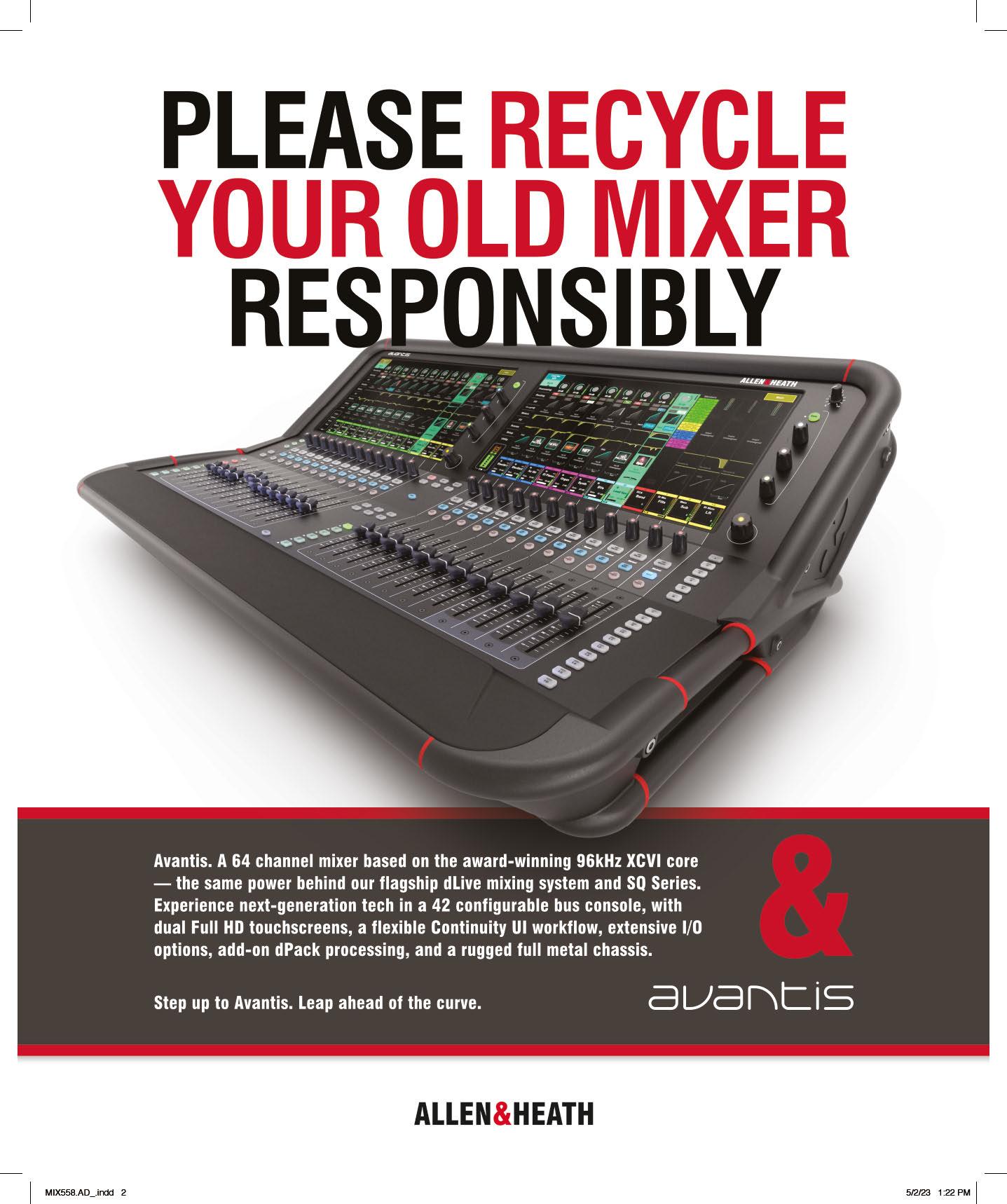




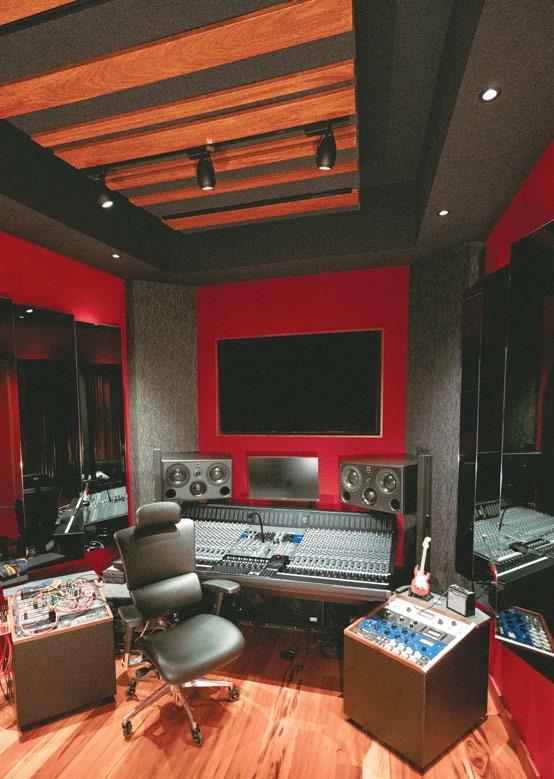















FOLLOW US twitter.com/Mix_Magazine facebook/MixMagazine instagram/mixonlineig
CONTENT
VP/Content Creation Anthony Savona
Content Directors Tom Kenny, thomas.kenny@futurenet.com
Clive Young, clive.young@futurenet.com
Senior Content Producer Steve Harvey, sharvey.prosound@gmail.com
Content Manager Anthony Savona, anthony.savona@futurenet.com
Technology Editor, Studio Mike Levine, techeditormike@gmail.com
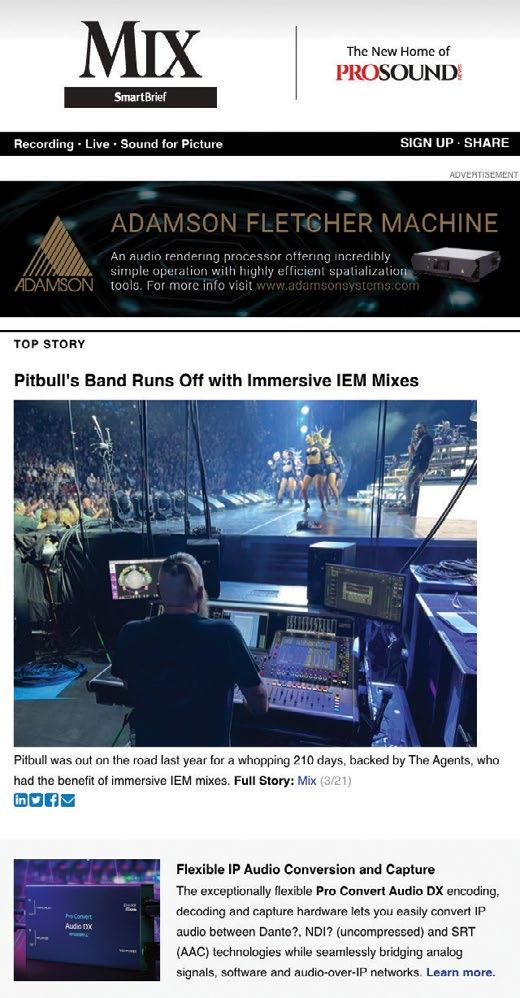

Technology Editor, Live Steve La Cerra, stevelacerra@verizon.net
Contributors: Craig Anderton, Barbara Schultz, Barry Rudolph, Robyn Flans, Rob Tavaglione, Jennifer Walden, Tamara Starr
Production Manager Nicole Schilling
Group Art Director Nicole Cobban
Design Directors Will Shum and Lisa McIntosh
ADVERTISING SALES

Managing Vice President of Sales, B2B Tech Adam Goldstein, adam.goldstein@futurenet.com, 212-378-0465
Janis Crowley, janis.crowley@futurenet.com
Debbie Rosenthal, debbie.rosenthal@futurenet.com
Zahra Majma, zahra.majma@futurenet.com
SUBSCRIBER CUSTOMER SERVICE
To subscribe, change your address, or check on your current account status, go to mixonline.com and click on About Us, email futureplc@computerfulfillment.com, call 888-266-5828, or write P.O. Box 8518, Lowell, MA 01853.
LICENSING/REPRINTS/PERMISSIONS

Mix is available for licensing.
Contact the Licensing team to discuss partnership opportunities. Head of Print Licensing: Rachel Shaw, licensing@futurenet.com
MANAGEMENT
SVP Wealth, B2B and Events Sarah Rees
Managing Director, B2B Tech & Entertainment Brands Carmel King
Managing Vice President of Sales, B2B Tech Adam Goldstein
Head of Production US & UK Mark Constance
Head of Design Rodney Dive
FUTURE US, INC.
Future US LLC, 130 West 42nd Street, 7th Floor, New York, NY 10036
in England and Wales. Registered office: Quay House, The Ambury, Bath BA1 1UA. All information contained in this publication is for information only and is, as far as we are aware, correct at the time of going to press. Future cannot accept any responsibility for errors or inaccuracies in such information. You are advised to contact manufacturers and retailers directly with regard to the price of products/services referred to in this publication. Apps and websites mentioned in this publication are not under our control. We are not responsible for their contents or any other changes or updates to them. This magazine is fully independent and not affiliated in any way with the companies mentioned herein.
If you submit material to us, you warrant that you own the material and/or have the necessary rights/ permissions to supply the material and you automatically grant Future and its licensees a licence to publish your submission in whole or in part in any/all issues and/or editions of publications, in any format published worldwide and on associated websites, social media channels and associated products. Any material you submit is sent at your own risk and, although every care is taken, neither Future nor its employees, agents, subcontractors or licensees shall be liable for loss or damage. We assume all unsolicited material is for publication unless otherwise stated, and reserve the right to edit, amend, adapt all submissions.
We are committed to only using magazine paper which is derived from responsibly managed, certified forestry and chlorine-free manufacture. The paper in this magazine was sourced and produced from sustainable managed forests, conforming to strict environmental and socioeconomic standards.

The story of the day my sister Bitta was born will be told for generations in the Kenny family, embellished slightly in each re-telling, no doubt, but with a baseline of a few irrefutable facts. First, my mom was in the Jasper County Hospital, having gone into labor early that morning. Second, my brother Mike, in the third grade, also went to the hospital, having just had a hardplastic playground swing come back at maximum speed and knock out all of his front teeth. Third, there were six children in the kitchen under the age of 12, being watched after school by family-friend Barbara Ryan, who was at the electric stove when it caught on fire and flames leaped to the ceiling.
Dad was at work when he got a call from the hospital, not pausing to listen to the message. He rushed over thinking he had a new baby girl and was greeted by his bloody 8-year-old son. He didn’t yet know about the stove. It was one of those afternoons that led to one of those evenings where, once the dishes were done and the kids were in bed, the parents might decide to have a nightcap on a school night, sink into the couch with a sigh, and say to one another: “Well, that sure was an eventful day!”
Fifteen years later, there was a Thanksgiving that nearly rivaled the Bitta birth day, involving, once again, mom in the hospital, dad returning from an early morning 10K run with a painful, twisted ankle (two brothers helping him walk), grandparents drinking Manhattans and a sister, wearing shorts, who pulled a pan of sweet potatoes out of the oven and directly into her lap, letting out a scream that shook the house.
If a newspaper notes that last night the City Council meeting was “eventful,” I think of screaming parents wielding pitchforks; at the very least, it’s likely that not much business took place. If it’s reported that it was an “eventful night in Oakland,” I’m guessing that it’s not a story about a surprise parade or a group of social workers handing out meals.
We usually associate “eventful” with the idea of unexpected or jarring elements packed into a day, a week or a month; it doesn’t matter. The feeling is that you have somehow dodged a bullet and can now shake your head and say, “Shwew!”
I, however, tend to be a glass-half-full kind of guy. To me, “eventful” is a full eight-hour day at Magic Mountain, followed by two hours at a waterpark to cool down, then a stop at a favorite restaurant, maybe even an ice cream, on the way home. Or the first day of a week in New York, where you hit MOMA in the morning, lunch at Katz’s Delicatessen, swing by the Museum of Natural History in the afternoon, stop by the hotel to change before a Broadway show, finishing up with a late dinner down in The Village. Now that is an eventful day! I must get that sense of optimism
from my mother’s side; her memoir is titled Celebrate Everything.
I say all this because now, finally, in the summer of 2023, it seems that Events Are Truly Back. When the world casually noted that the pandemic dealt a catastrophic blow to “events,” we tended to focus on the big events like concert tours, trade shows, Apple product launches, football games or the Olympics. The scale seemed too big to fathom. But it was also every wedding date, family reunion, club meeting, back-to-school night, library reading hour or studio opening. Each of the studios featured in our Class of 2023 was able to have a real opening party this year. To their owners, that’s just as big a deal as the return of the in-arena audience to the NBA playoffs.
Every major concert tour that announced a Bay Area date for this summer seemed to announce a second, then a third date soon after. Try booking a wedding in June for the next three years; it’s pretty crowded. Look at the cost of flights these days. People are on the move, people are going to events again. Mix has a big immersive music event in Nashville one week after I write this, and it has filled up with engineers eager to be back in the room.
I know that the return of events really began last summer, but I consider that a trial run. This summer, it’s real.
We have to be careful in how we measure the success of those anchor events in our business or personal lives. Take trade shows, for instance. We are now measuring the success on the creeping increase in numbers, the goal being “back to pre-pandemic levels.” Well, in some cases, that might be an accurate gauge, but the world has changed and we may have to find new metrics to measure the success of an event. Numbers don’t tell the whole story. Yes, NAMM numbers were down. I happened to have a great show.
It’s not the physical location or setup that makes a good event also an eventful one. It’s the feeling you get as you come away from the event, whatever it may be, and re-enter your normal world. I don’t have any real memories of the day my sister was born except an image of the stove fire that still lives in my head—but I do remember the feeling pretty well. The feeling of controlled chaos, uncertainty and the underlying tension that can fill a home when things are noticeably out of whack, but nobody really knows what’s going on. I remember that it felt kind of exciting. It was certainly “eventful.”
Tom Kenny, Co-Editor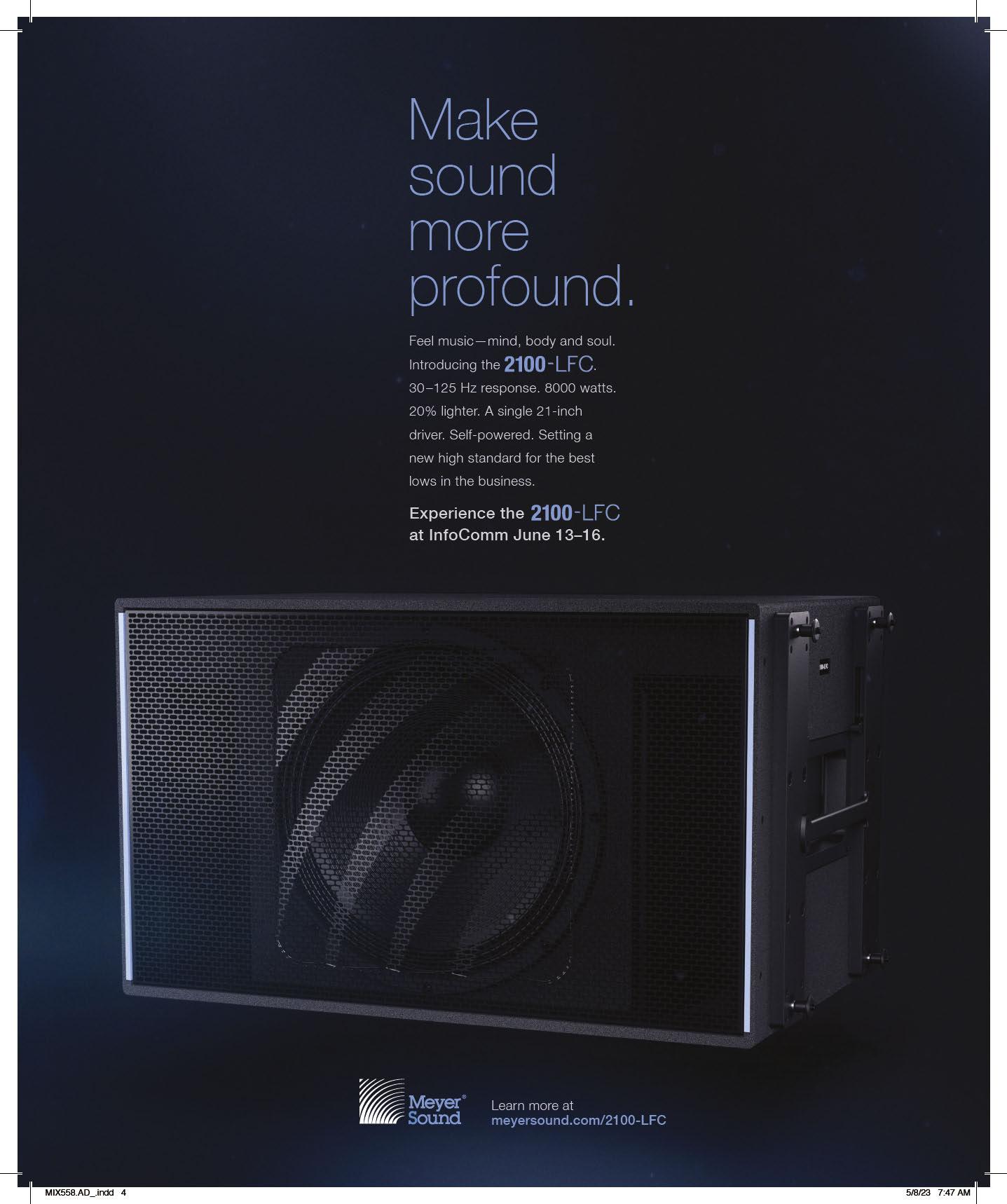

Washington, D.C.—Librarian of Congress Carla Hayden has named 25 recordings to the National Recording Registry, including iconic songs by Madonna, Mariah Carey and Led Zeppelin.
The latest selections named to the registry span from 1908 to 2012 and range from the first recordings of Mariachi music and early sounds of the Blues to radio journalism leading up to World War II, and iconic sounds from pop, country, rock, R&B, jazz, rap and classical music.
Madonna’s cultural ascent with “Like a Virgin,” Mariah Carey’s perennial No. 1 Christmas hit, Queen Latifah’s groundbreaking “All Hail the Queen” and Daddy Yankee’s reggaeton explosion with “Gasolina” are some of the defining sounds of the nation’s history and culture that will now join the National Recording Registry. The 2023 class also includes the first sounds of a
video game to join the registry with the Super Mario Bros. theme, powerful voices of women, important inductions of Latin music, and classic sounds of rock and pop from the 1960s to the ’80s.
This year’s class includes “Sherry” by The Four Seasons in 1962, “What the World Needs Now is Love,” recorded by Jackie DeShannon in 1965 and written by the late songwriting duo of Hal David and Burt Bacharach, “Imagine” by John Lennon and Yoko Ono in 1971, Led Zeppelin’s “Stairway to Heaven” from 1971, “Synchronicity” by The Police in 1983, and more unforgettable recordings.
Also included are “Take Me Home, Country Roads,” recorded by John Denver in 1971; the second album, Déjà Vu, by Crosby, Stills, Nash and Young, which features “Teach Your Children,”
Fairfax, Va.— At InfoComm 2023, which is being held June 10-16 in Orlando, Fla., AVIXA will continue its commitment to diversity, equity and inclusion.
“AVIXA is very proud of the work we are doing with the AV community to bring discussions on DEI out in the open and support programs that are making a positive impact,” said David Labuskes, Chief Executive Officer of AVIXA. “We want everyone to feel welcome to this exciting industry, because everyone deserves to belong and for their story to be heard.”
It is critical that the environment where InfoComm is being hosted is inclusive, he added. “Laws that adversely affect women, LGBTQ+, Black, Latino, Asian, Indigenous, disabled persons and others are not in line with AVIXA’s values. Orange County, Florida, the home for InfoComm 2023, shares our dedication to DEI
and takes deliberate action to support diverse communities.”
In 2021, AVIXA began the “pass the mic” initiative, where speakers are asked to include and support colleagues to present sessions at InfoComm to amplify more diverse voices and points of view. This program is yielding positive results—the InfoComm 2023 current speaker lineup is 26 percent female or non-binary and 25 percent minorities.
InfoComm 2023 will also present sessions on
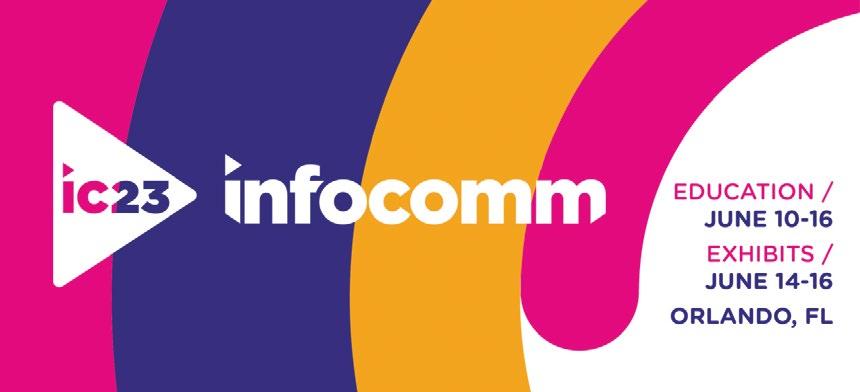
“Our House” and “Woodstock;” Eurythmics’ “Sweet Dreams (Are Made of This);” and Jimmy Buffett’s “Margaritaville.”
“The National Recording Registry preserves our history through recorded sound and reflects our nation’s diverse culture,” Hayden said. “The national library is proud to help ensure these recordings are preserved for generations to come, and we welcome the public’s input on what songs, speeches, podcasts or recorded sounds we should preserve next. We received more than 1,100 public nominations this year for recordings to add to the registry.”
The recordings selected for the Library of Congress’ National Recording Registry bring the number of titles to 625, representing a small portion of the national library’s vast recorded sound collection of nearly 4 million items. n
how organizations can go beyond conversations about race and take action for racial and gender equity, and the importance of leadership being purposeful about implementing DEI practices. For example, “Diversity & Equity in the Modern Workplace: Intentional Leadership” will feature industry DEI experts sharing experiences and success stories on how belonging is a powerful sentiment that needs to be understood by leaders and ingrained into an organization’s DNA.
A discussion, “An Ethical Revolution in Tech: Creating DEI Accountability and Psychologically Safe Workplaces,” will bring together a crosssection of the industry to share insights for change at every level. From the perspectives of workplace leadership, management allyship or passionate outspoken employee perspective, this session will provide real-world examples.
The annual AVIXA Women’s Council Breakfast will feature keynote speaker Dr. Tarika Barrett, CEO of Girls Who Code. Dr. Barrett will shine a light on the transformative power of learning spaces where women can collaborate to problem-solve, innovate, and envision themselves as leaders and equals in their fields. n
 By Beth Walters & John Storyk, WaltersStoryk Design Group
By Beth Walters & John Storyk, WaltersStoryk Design Group
One morning over 30 years ago, we were sitting in the newly created office we’d opened in upstate New Paltz, N.Y., when a slim, dark-haired and extremely confident young woman walked in and announced that she was available to work for us.
Her name was Nancy Flannery, and her previous employment history was as assistant to Sally Grossman, wife of famed music industry talent manager (and Woodstock, N.Y., entrepreneur) Albert Grossman, for whom John (Storyk) had designed a local recording studio, performance venue, home and office expansions and related establishments. Sally had suggested that Nancy talk to us about “a more challenging position.”
We weren’t all that busy at the time, but Nancy agreed to come onboard as our bookkeeper. In time, as our business (and staff) continued to expand, Nancy’s amazing capacity for grasping, organizing and ameliorating our increasingly complex business issues made her an indispensable member of our team. She was our lynchpin, the glue that kept all of WSDG’s disparate projects and staff in order. She was, in a sense, the very soul of our operation.
As the years passed, we grew from a local Highland/Woodstock/Kingston operation into a global business, with offices in Switzerland, Germany, Latin America, China, Saudi Arabia, and other far-off lands. We also shifted WSDG’s organizational management from two principals to a more realistic “corporate democracy.” Longterm associates were named Partners and awarded formal titles. Nancy Flannery became Partner/CFO.
She was a Force of Nature. Her increasing financial management expertise, her extraordinary memory, and her amazing people skills made her both invaluable and indispensable. Nancy was also our Den Mother. She’d invite new (and occasionally homesick)
young interns to home-cooked family dinners with her husband (and former high school sweetheart), Mike, and daughters Clara, Marisa and Ainsley. Nancy loved dogs, music, good food and life in general. She had boundless energy, but she did not suffer fools gladly.
Tragically, on a Tuesday morning, March 28, 2023, Nancy Flannery died of a heart attack. Her passing was totally unexpected and remains incomprehensible. Our lives and our world were greatly diminished by her passing. She will be terribly missed, but never forgotten. n

You may not know the name Paul Cox, but I can guarantee that you’ve heard music produced in some of the rooms for which he has provided technical design and integration. His clients include Stevie Wonder, Trent Reznor, Harvey Mason, Jr., Kenny “Babyface” Edmonds, Jimmy Jam and Terry Lewis, Beyoncé, and on and on.
Then there are the commercial and corporate clients, including major record labels and global media and entertainment companies. He’s built some of Hollywood’s busiest film and TV stages, home studios for artists, and everything in between.
Who better to talk to about changing and evolving studio technical trends over the past 40-plus years?
I’ve known Paul [full disclosure] since the day he started working with us as a tech at Amek—the day of the Northridge earthquake, January 17, 1994. He went on to work with SSL, commissioning many of the first J Series consoles in the U.S., but his goal was always to build rooms; it’s what he’d done for a decade in London before moving to Los Angeles in 1992. He had started building radios and tinkering with electronics at the age of eight, was in a band as a teenager and dropped out of college—after
just two days—to assist and tech for a wave of newly freelance engineers such as Alan Moulder. Those sessions led to more tech work, building and maintaining studios for The Jesus and Mary Chain and Curve, and also touring with both bands, as well as Thrashing Doves, Then Jericho and Tears for Fears.
Cox prefers designing and integrating bespoke studios for artists versus commercial facilities, which, while not exactly cookie-cutter, tend to follow a similar set of standard practices. “I really enjoy working directly with artists who are keyboard-heavy, where every room is completely tailor-made for their particular workflow,” says


Cox, who owns a formidable collection of vintage keyboards and drum machines himself.
To his mind, the evolution of studio technical design is tied to the mixing console, or lack thereof. In the 1990s, it was not unusual for a studio to have a 96-input-plus analog mixing desk costing $800,000 hooked up to a tape machine costing a quarter-million dollars. Subsequently, digital desks emerged as an alternative along with the digital audio workstation, leading eventually to hybrid—and much more affordable—workflows combining a DAW, interfaces and an analog front and back end, whether that was an assortment of outboard devices or one of the newer generation of compact consoles.
Those massive consoles of the ’90s came with additional costs, he also points out. “They needed $5,000 a month for power and air conditioning,” he says, noting that the componentry inside the desks has evolved, too. “Now a console kicks out as much heat as a hair dryer and is just pennies to run.”
Back in the day, artists would have every device in the room permanently wired, often through dozens of DI channels, into their console. Now, he says, they are more likely to simply patch a couple of devices through an interface for a writing or tracking session.
As artists and engineers embraced the slimmed-down, hybrid workflow, some would


add a sidecar of vintage console modules as a DAW front end. “This was before the market was flooded with monitor control systems,” Cox says, “but wouldn’t it also be nice if we had a stereo bus, some form of monitoring and maybe a cue system?” Soon enough, a new generation of compact consoles emerged to support the hybrid setup: “So now you’ve got fader control, DAW control, an analog front end, proper monitoring—the best of both worlds.”

While many vintage desks have been taken apart to make those sidecars, a few complete consoles survived, and some have found homes with several of Cox’s clients. “I really love restoring things, taking something that was once brand new and beautiful, then neglected and abused over the decades, and putting it back to the way it was,” says Cox, who, in his spare time, has also restored a couple of award-winning 1956 Cadillac Eldorados and a 1979 Kenworth K100 semi truck.
Operationally, those old desks are not for everyone, he cautions: “I find that some engineers struggle with some of the vintage consoles, which can have very strange internal operating levels and, by modern standards, quite bizarre signal-flow structures. Also, some of these older consoles didn’t offer much in the way of EQ, because you were never meant to salvage a train wreck with it.”
Cox, who has seen many classic consoles come through his workshop, each unique in ways both positive and negative. With EMI’s TG consoles, for example, cost was no object when they were built, so the quality and components were top-notch, but nothing is built to last
forever, and repairing a module—a cassette, as EMI called it—is a painstaking task.
“You can spend the best part of a day taking one switch assembly apart, finding the issues and correcting them, and putting the thing back together,” Cox explains. “I’m only happy doing things to a certain standard, and there’s a lot of people who aren’t willing to pay for that level of attention and detail—but the people who do own these consoles generally have a love for the art, the history and the whole recording process.”
For all the technological advances, there is still something to be said for a simple analog signal path, Cox believes. “A studio’s tech design is only as reliable as the weakest link,” he says. “It seems that the more technologically advanced it gets, the more wasted time there is with computer-related problems. When it was an analog console with an analog tape machine, you could always work around a problem. I also like the idea of being able to play material without having to boot three different computers, or being dependent on a whole string of events to make that possible.” Accordingly, his integration plans typically enable such tasks to be achieved without jumping through hoops.
Now, of course, musicians can work in a spare bedroom and book time at a commercial studio just to track drums, brass or strings. That way of working has also hastened the end of dedicated mixing rooms, he observes. “With some inserts to and from analog gear and what have you, engineers are perfectly happy working in the DAW—and the results are amazing because they have amazing ears and a particular skill.”
So, affordable production technology has advanced the artform in some respects. “It has also allowed a lot of people access to things that they probably shouldn’t have,” Cox chuckles. “Music quality should be better than it is. You used to hear great stuff all the time, but these days, when you hear something that’s astoundingly well-recorded and mixed, it’s quite a revelation.”
That aside, Cox says, “There’s something to be said for a Mac, a good-quality interface, a pair of good speakers, a keyboard, a bunch of plug-ins and a nice vocal mic in a bedroom with some acoustic treatment. There’s nothing to say that isn’t as good as a commercial facility, as a great musical idea is, and always will be, king. Plus, a skilled set of ears to know what you have and what you need to do; there’s no substitute for that.” n

CHICAGO, ILL. When chief engineer and studio owner Matt Hennessy upgraded his Chicago studio for Dolby Atmos, he chose Genelec’s “The Ones” compact three-way Smart Active Monitors.
VSOP Studios joined the ranks of Chicago’s elite recording facilities when it opened in 2016, in the city’s West Town neighborhood. Hennessy, who designed the studios with general contractor and architect Lane Wintz, took that up another notch when he implemented Dolby Atmos mix capability in Studio A in 2022.

“It had to be Genelecs for this move into immersive mixing,” says Hennessy, who trained at Berklee College of Music, where he studied both jazz performance and production before beginning a two-decades-plus career manning consoles for artists including Twista, Jay-Z, Beyoncé and DMX. “I’ve been using the 1031As since the early 2000s, with a 7070 sub. They’ve been in pretty much every room I’ve ever worked in, and I love them.” Those same 1031A monitors are still working, in VSOP Studios’ B room.
The new Genelec 7.1.4 array comprises three 8351B SAM studio monitors for the LCR, eight 8341As for rear, side and overhead surrounds, and a 7380A SAM subwoofer.
“The sound is great, as always, but the automatic calibration capability is critical for monitoring in this format,” Hennessy explains. “You want to have the speakers precisely positioned and equidistant from each other, but you can’t always achieve that symmetry perfectly with a dozen speakers, and there are always obstacles and aspects of the room itself that can be acoustically challenging. We got them as well-positioned as we could, and they sounded fantastic just out of the box, but once we ran the SAM tuning, with phase and time alignment and bass management, it was night and day! It just blew me away.” n
OAKLAND, CALIF. In mid-April, burglars stole recording equipment and musical instruments worth thousands of dollars from the Bay Area’s long-running Tiny Telephone Studio. Owned and operated by indie music stalwart John Vanderslice, the facility lost all its electric guitars and basses, as well as numerous high-end microphones, including a 1961 Telefunken U47 that Vanderslice estimates was worth $38,000.
According to a GoFundMe page that Vanderslice set up, no one was hurt during the burglary, but the damage to the studio and its staff is difficult to bear. He noted, “Early on the morning of April 15, we experienced every recording studio’s worst nightmare: A crew forced their way through two reinforced doors, broke into Tiny Telephone and stole a number of items from the studio.”
Over the years, acts like Death Cab for Cutie, St. Vincent, Sleater-Kinney, Deerhoof, Spoon
and The Magnetic Fields have recorded at Tiny Telephone locations. Originally based in San Francisco, Tiny Telephone was founded in 1997, and with help from crowdfunding, built out a second Oakland location in 2016. The resulting 3,000-square-foot room with 22.5-foot ceilings was originally created to ease demand for the San Francisco location, which was perpetually booked at the time.
With Tiny Telephone’s Oakland location now burgled, the challenges remain. “We’re a small arts organization in Oakland, without any kind of corporate backing or tech money behind us,” he wrote on GoFundMe. “At our current rates, it would take years of booked studio time to pay for everything…. The cost of fixing and reinforcing all three points of entry alone to prevent future break-ins is around $15,000.”
Vanderslice has set a crowdfunding goal of $70,000 to replace some of the stolen items,
repair damage to the facility and improve the studio’s security. His aim is to refrain from raising rates for clients. “We want to remain affordable for new artists and foster a democratic and accessible culture for bands of all levels to make masterpieces here. (And they do!)” n



SANTA BARBARA, CALIF. For the past 17 years, non-profit organization Notes for Notes (N4N), an advocate for music in public schools, has built recording studios nationwide, all outfitted with KRK monitors through the manufacturer’s charitable arm, KRK Kares
N4N’s most recent studio is powered by Sony Music Group at the Boys & Girls Club of Metro L.A.’s Watts/Willowbrook neighborhood and was stocked with KRK Classic 7, Rokit 10-3 G4, and Rokit 5 G4 studio monitors, as well as the brand’s KNS 8402 headphones. With KRK Kares’ latest donations, every Notes for Notes studio is now equipped with KRK at every level, giving youth at 26 studios across 13 states the ability to produce, record and mix like the pros while learning the ins and outs of music creation.
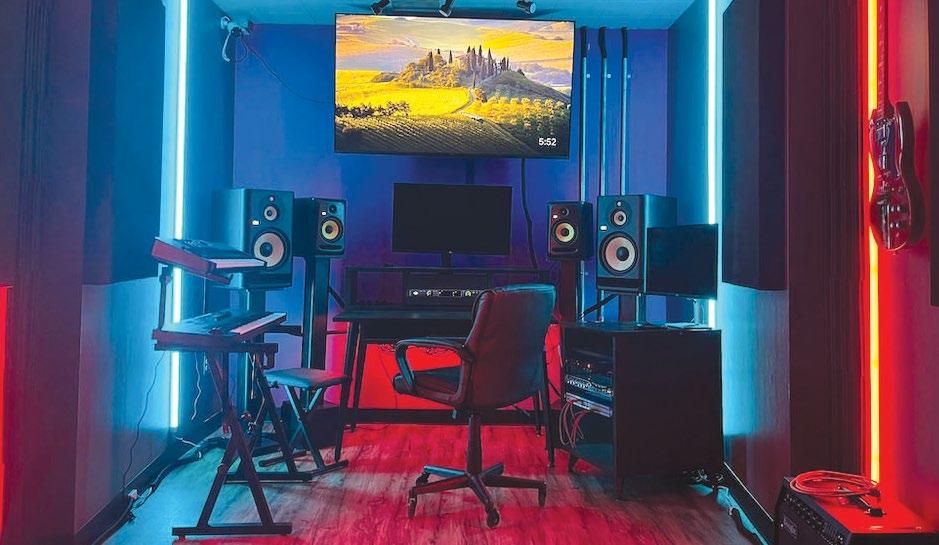
“Both KRK and Gibson, and subsequently KRK Kares and Gibson Gives, have been there for the majority of our growth, providing some of the most important gear for our studios,” says Notes for Notes CEO and co-founder, Philip Gilley. “KRK has provided equipment for our facilities since studio number three. Monitors and headphones are core staples of any recording studio, and we wouldn’t have been able to complete those builds without them. In fact, we always make sure we’ve got those nice big, bright, yellow cones front and center at all our mixing stations.”
The Watts/Willowbrook Clubhouse also features multiple Epiphone guitars and bass guitars, MESA/ Boogie California Tweed amps, and a selection of guitar pedals from Maestro Electronics.
Gilley adds that it’s not just the recognizability that makes KRK products fit N4N. “Obviously, there’s a quality aspect to consider when choosing KRKs, but there’s also something to be said for the fact that this gear is attainable to young people,” he explains. “The same goes for other Gibson brands, like Epiphone, Kramer, and Gibson guitars. Youth at our studios become accustomed to these brands when they’re first learning and growing, and these are the brands they will reach for when they can afford their first guitar or pair of monitors. Providing gear that’s within their financial reach is very important to us.” n

Over the past 30 years, Cirque du Soleil shows have become an integral part of Las Vegas nightlife—epic theatrical productions filled with death-defying acrobatics, breathtaking scenery, impish characters and more, all delivered in family-friendly, romanticized presentations that are almost otherworldly. And then there’s Mad Apple. A tribute to New York City, the show is extremely worldly—forget the “other”—as well as in-yourface, bawdy and a lot of fun. Yianni Epivatinos, sound designer and production services sound manager for all of Cirque’s Vegas shows, said simply, “It’s a party.”
Presented at the New York–New York Hotel & Casino, the high-octane, 90-minute show is staged twice a night, five nights a week, serving up six acts ranging from jugglers to acrobats hanging by their hair to The Wheel of Death. There’s also large helpings of standup comedy, slick genre-mashing musical performances, showstopping dance numbers and, of course, shadow puppets.
While it’s a new show that opened only last year, Mad Apple took over its 1,200-seat theater from Cirque’s Zumanity, which ran for 17 years until the pandemic brought that production to an end. As a result, when gearing up for the new show,
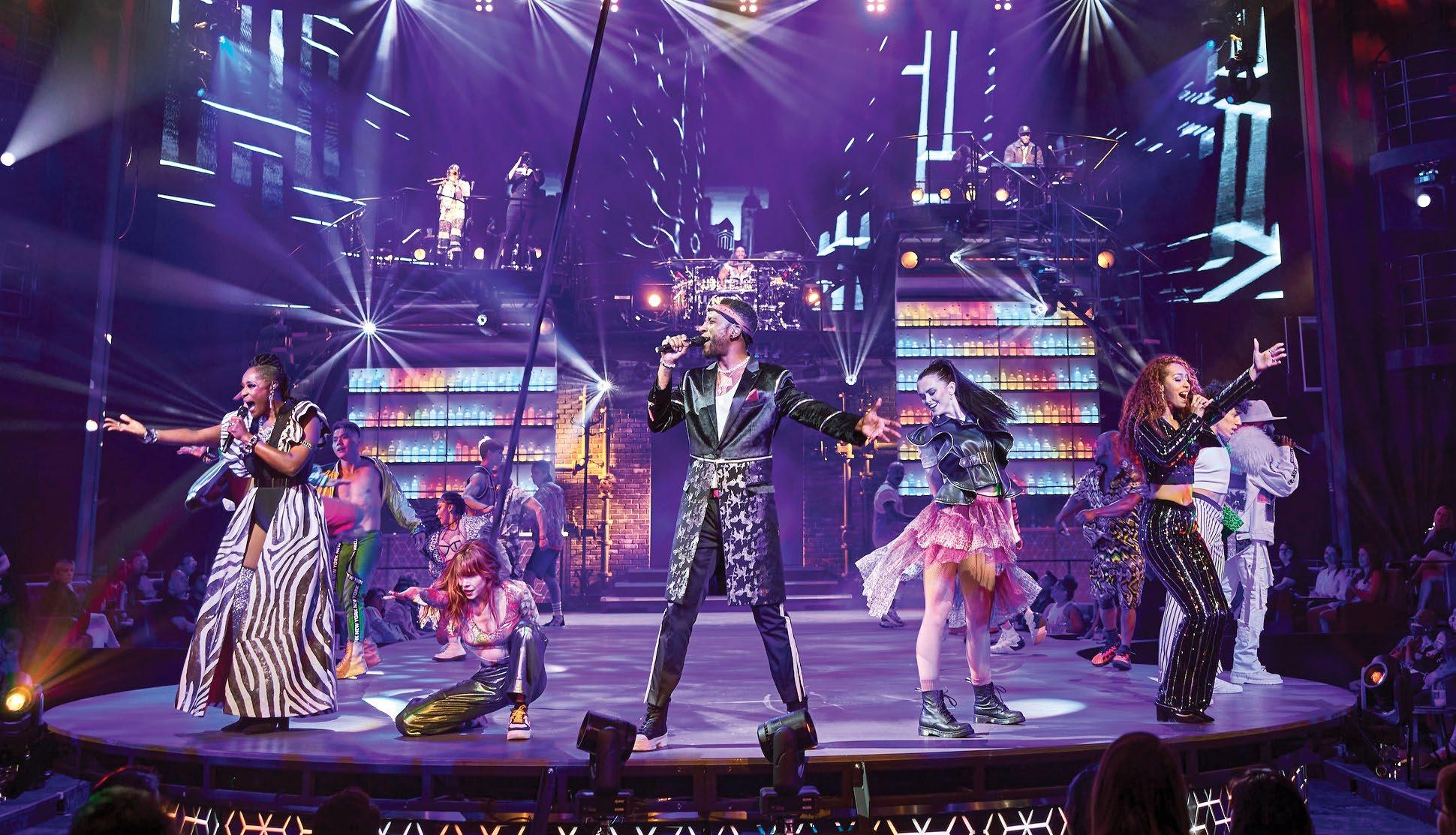
Epivatinos and the audio team knew the theater well, and opted to keep some elements of the existing audio system while updating other parts.
The house system was retained, though Epivatinos used the opportunity to retune the room, improving sound and minimizing dead spots. Based around Meyer Sound CQ Series loudspeakers and 650 Series subwoofers, the system also sports QSC-powered Nexo PS8 and PS15 boxes for delays and the occasional surround speaker. Even though much of the show takes place in front of the P.A. often high above the audience, speaker placement wasn’t affected by having to accommodate unusual acts

such as acrobats.
Much of the system update centered around networking, swapping out an old Peavey MediaMatrix setup for a BSS-aided fiber net-work that now ties in a pre-existing ClearCom pointto-point and FreeSpeak II IP Beltpack system. The ClearCom gear, along with a behind-the-scenes set of CCTV cameras, is crucial on a show where performers may disappear into the rafters or the floor at the end of an act. “The CCTV system and the intercom system are most important because of safety; if we lose communication, nothing works,” said Epivatinos. “We have cameras with different views of the room so that people up in the booth can hear the ‘clears’ from the other technicians at the same time that they have eyes on it—and before they move [a set piece]—to make sure we’re doing everything safely.”
Other upgrades to the show include the addition of Avid S6L consoles at front-of-house and in a backstage monitor room, mixing 48 channels from the five singers and six-piece band of multi-instrumentalists, as well as some digital tracks. Because the show doesn’t have an overall plot, it’s constantly evolving, with the six acts variously getting swapped out as needed, so using snapshots on the consoles is crucial.
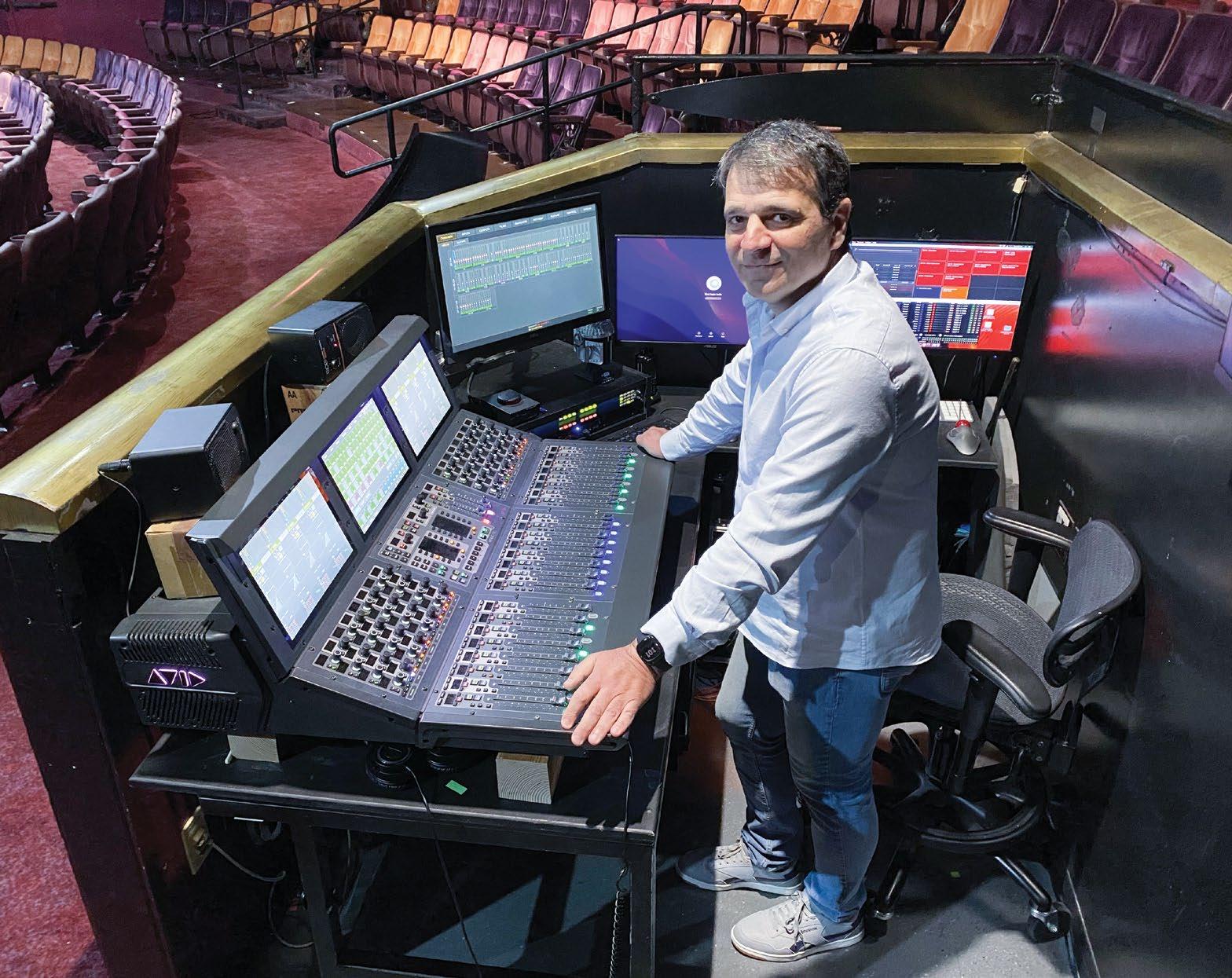
“Everything gets pre-produced and premixed to pretty much how it’s going to sound, as we have to keep our levels,” said Epivatinos. “We pay attention to hearing conservation, so everything’s very set—but the house engineer has to really mix it. There are some support tracks on some parts, sure, but it’s not anything major; if you listen to the show, it’s live and it’s really happening. There are human beings playing—they’re very good, very consistent, but they’re human beings—so he has to mix it accordingly.”
There’s a lot to mix, too—while the singers
and musicians have a bandstand high above the action, they’re just as often running around the stage itself, brandishing keytars, brass instruments, portable drum sets and more, all well in front of the P.A. While the various musicians each wear in-ear monitors—mostly Ultimate Ears—the other performers don’t require monitoring for their acts.
All five singers belt nightly into Shure Axient Digital wireless systems with KSM11 cardioid condenser vocal capsules. “We started the show with KSM9s for the vocalists, then KSM11 came out and I loved it,” said Epivatinos. “I got some demos to try them, and Shure couldn’t get them back! The first time we tried the KSM11, the singers heard them and said ‘Wow.’ I said, ‘Yeah, I agree—that stays here.’ It’s an incredible mic.”
Elsewhere in the production, the extensive drum kit is captured with a Shure Beta91A and Beta52A in the kick drum, while cymbals are heard via KSM137s and the toms are nabbed with Sennheiser 904s. Elsewhere, DPA 4099s are used on all brass—saxes, trumpets, trombone and the like. While the mic selections are varied, they all serve the ultimate goal of creating a great-sounding show. “I’m always going to get the 91 and 52 for bass drum because I just feel
comfortable using them, I know what to expect and I know I’m going to get the sound I want out of them,” said Epivatinos. “I’m not saying this is the best mic money can buy; I don’t know if it is—but it is for me.”
Keyboard-world up on the bandstand centers around Roland RD-2000 and Fantom G7 keyboards, joined by a Moog Matriarch, redundant Ableton setups, Apogee Symphony I/O Mk II interfaces, and a Radial switch on hand for switching systems in an emergency.
All of it makes for a show that is determinedly not a typical Cirque du Soleil production. “You have this incredible band, and it’s more like a rock ‘n’ roll show than a theater show,” said Epivatinos. “In other Cirque shows, we mix the action—everything in those is an experience, so the music is like a live music score, a soundtrack that supports the action you’re watching. With Mad Apple, the music is the main focus, and it’s punchy, it’s fun! Plus, this show changes a lot—they bring in new ideas, new acts, so for our engineer, it’s not like mixing a play where it’s the same show every night. It changes over time and keeps you on your toes. We find this very challenging and entertaining because you never get bored ever!” n
“If you listen to show, it’s live and it’s really happening. There are human beings playing—they’re very good, very consistent, but they’re human beings—so he has to mix it accordingly.”


FAIRFIELD, CALIF. —Mount Calvary Baptist Church in Fairfield, Calif., recently updated its long-serving audio system with the help of Keith Wackford, Sales and Production Manager at Sacramento Production Services.
“They wanted a new system that offered personal monitor mixing for the band, and multitrack recording capabilities,” recalled Wackford. “They also run a lot of wireless, but with very little personnel to actually monitor and adjust it, so telemetry and control of wireless devices from the frontof-house console was crucial.”
After researching the market, Wackford’s team landed on an Allen & Heath dLive S7000 36-fader control surface, paired with a CDM48 MixRack. A 128-channel Waves card was added for multitrack recording purposes, allowing the church to capture and remix any performances using the isolated tracks.

A 128-channel Dante module was also included, which is used to interface with the church’s various Shure wireless devices. The dLive’s Shure and Sennheiser wireless integration feature enables the front-of-house engineer to monitor battery life of wireless microphones, as well as adjust input gain and view metering without having to be near the actual receivers. In addition, the Dante module distributes audio throughout the facility via a
Dante-enabled audio matrix processor. For personal monitoring, Wackford included a 10-port Allen & Heath ME-U hub that receives signal from the church’s dLive mixrack and feeds that audio to the church’s seven ME-1 personal monitor mixers, along with channel names and stereo link information. The ME-U also provides PoE along the same data cables, which eliminates the need for individual power supplies to each ME-1 mixer.
The stage was expanded during the overall audio upgrade, so a DX168 16-input, 8-output stagebox was added to reduce overall cable runs to the main CDM48 MixRack. “Being able to run simple CAT5e through a floor pocket closer to where the band was made it much easier without having to create a whole panel or wall plate,” recalled Wackford. Wackford notes that he often chooses dLive when a client needs room for growth. “For churches that don’t know where they are going to be four, five, ten years down the road—to have that expandability is crucial,” he explained. “You may only have 32 mic preamps in your MixRack, but someday you may need 64 or 128. It’s just a matter of adding another DX stagebox. You may even want to add a separate recording or broadcast desk; all that takes is a gigaACE card and you can easily share audio without needing to rely on a third-party protocol. It’s huge for us, and it’s huge for our clients, too.” ■
BACKNANG, GERMANY—d&b Group and its subsidiaries, d&b audiotechnik and d&b solutions, have joined the United Nations Global Compact initiative, a voluntary leadership platform for the development, implementation and disclosure of responsible business practices.
The UN Global Compact is an initiative that calls on companies to align their operations and strategies with 10 universally accepted principles in the areas of human rights, labor, environment and anti-corruption. By doing so, companies can make an impact on society while also supporting the UN goals and issues embodied in the sustainable development goals.
As members of the Global Compact, the group will have the opportunity to collaborate with other companies, civil society organizations and UN agencies to exchange best practices and to contribute to collective action toward sustainable development.
“Corporate social responsibility and environmental social governance have become key concepts in the business world in recent years, but for us are far more than just buzzwords, they are important guidelines and metrics that we have placed at the heart of our business,” commented
“In line with our commitment to these principles, we are proud to join the UN Global Compact. Voluntary initiatives such as these have produced tremendous positive social and environmental outcomes and have improved the lives of millions of people in the workplace and in communities around the world, and we look forward to sharing the benefits of the program with our many industry colleagues and customers,” Harman added.
Launched in 2000, the UN Global Compact is the largest corporate sustainability initiative in the world, with more than 15,000 companies and 3,800 non-business signatories based in over 160 countries, as well as more than 69 local networks. ■
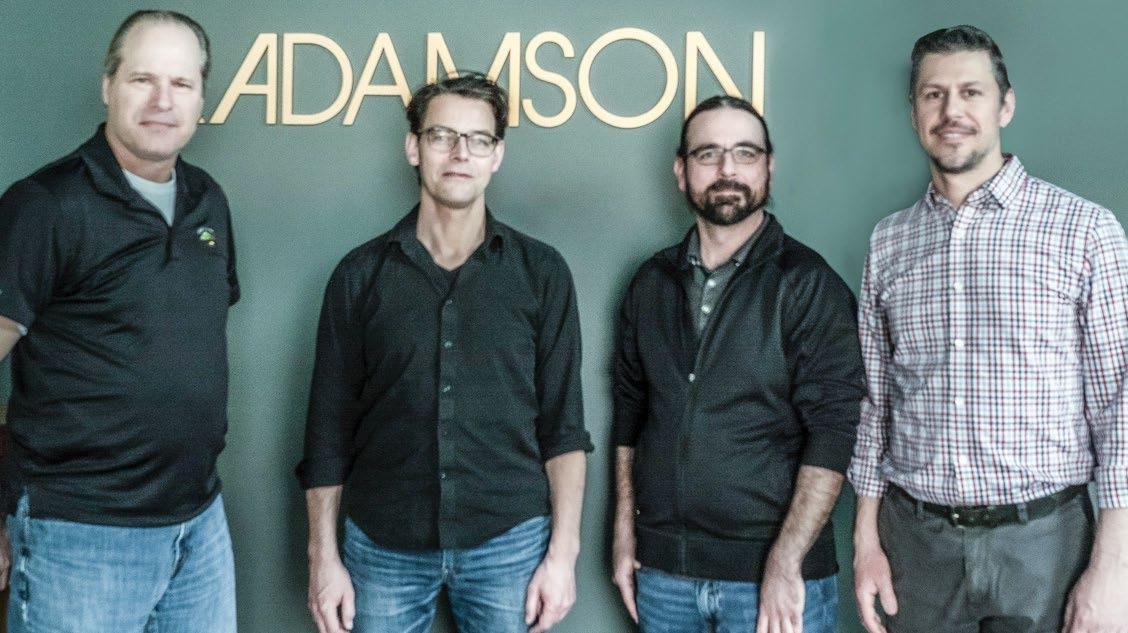
PORT PERRY, ONTARIO, CANADA—Canada’s largest fully integrated speaker manufacturer, Adamson Systems Engineering, has revamped its management team with the return of Brock Adamson as CEO, along with five new hires.
Over the last few years, the company has grown and radically upgraded its manufacturing facilities while also acquiring audio technology firms BeSpline and Brain Modular.


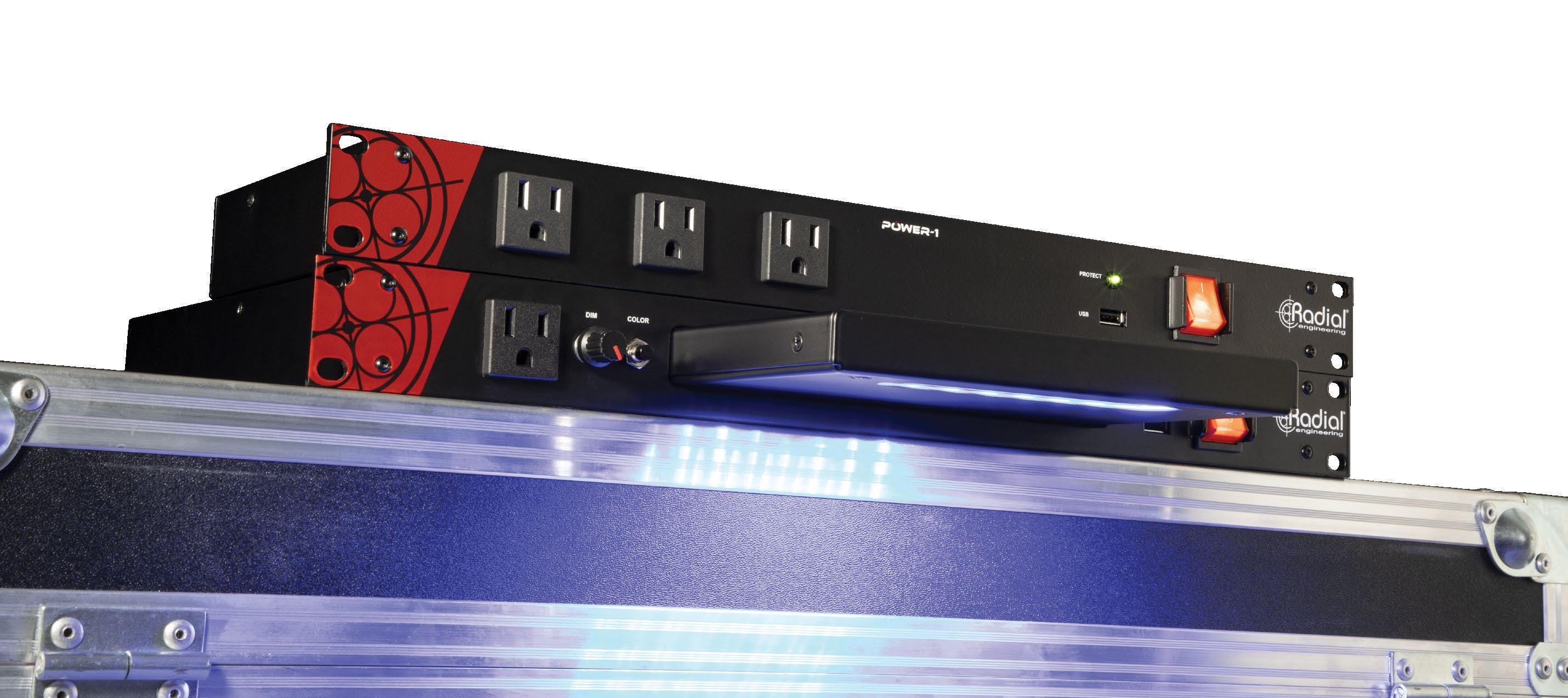
“I’ve lived and breathed Adamson from the very early days to our most recent factory expansion in Port Perry, even as I brought in Marc Bertrand to focus on strengthening our sales infrastructure,” said Adamson. “Returning as CEO is energizing and exciting. In 2022, we asked ourselves, ‘What is the ideal management team to fuel our continued growth?’ We’ve created that team. When I walk into the office now, I find myself working with a breadth of leadership talent that can execute our mission daily.”
Newly onboard at the company is Pieter van Hoogdalem in the new
Business Development Strategist position, focusing on alignment between sales, marketing and product. Hoogdalem provides hands-on audio industry knowledge and market growth experience with Landr Audio Inc. and Proshop Entertainment Inc.
Meanwhile, marketing consultant Kevin Alexander has also joined the company, bringing to the table his previous experience with TC Group and other audio brands. Paulo Guassi has taken on a new Production Management role. The new hires were made following the addition of Fred Schleicher as Controller and Duane Logan as ERP Specialist in 2022. ■
In Mix’s annual studio design issue, we present some of the most exciting new or refurbished studios that have opened during the past year. Included are innovative new workspaces for composers, musicians, engineers and producers all around the globe, starting with our cover studio.
Third time’s a charm. Legendary recording studio Q Division came back online in April 2023 after moving from Boston to Cambridge, Mass. The new studio, designed by Lou Clark of Sonic Space, should be the forever home base for Q Division co-founder Jon Lupfer, who is now the proud owner of his studio and building.
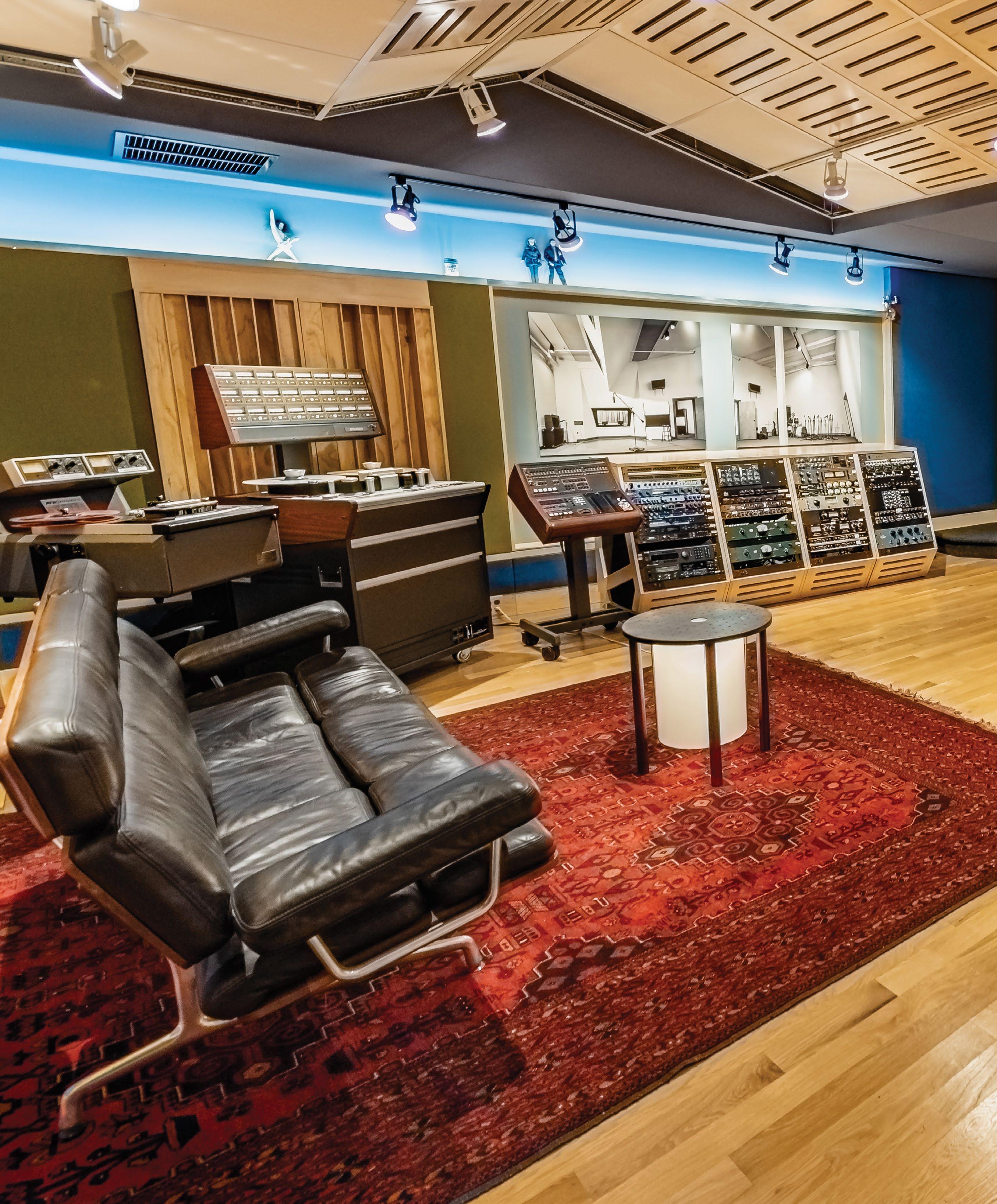
Q Division was first opened by Lupfer and his friend Mike Denneen in South Boston in 1986. After nearly 15 years of success, hosting artists such as Aimee Mann, Pixies, Letters to Cleo, Dead Milkmen, Gigolo Aunts and Jen Trynin, the studio owners were forced to relocate after their landlord decided to repurpose his converted
By Barbara Schultzwarehouse for high-tech tenants.
Fifteen years later, another landlord squeezed them out, though the studio owners were able to negotiate a five-year lease extension in exchange for moving their B room to a different space within the building; Clark designed that relocated B room, also. Sadly, Denneen passed away in 2018, but Lupfer went forward. He purchased the empty warehouse that has become Q Division 3.0, and again called on Clark for the studio design.
“The new building was just a big blank slate,” Clark says. “It was a concrete slab with a shell and new roof—just raw, open space. That gave us a lot of flexibility, but it also required…
everything.”
Similar to Q Division’s previous studio, the new facility has been designed with live performance in mind, with a range of acoustical signatures for different applications, and excellent sightlines between spaces, including the side view from the Control Room A mix position into the tracking room.

“I really grew to like that in the previous studio,” Lupfer explains. “You don’t have to look over the console, and so that connection between the rooms can be a lot more immediate; you feel more connected.”
Another carryover from Q Division’s previous studio is the rear-wall bookshelf in the
580-square-foot Control Room A.
“When Mike, my partner, and I met and were first playing in bands together, we were in high school,” says Lupfer. “There was a performance space there that was also a library, and that taught me that I actually like books as an acoustical treatment. We had a cabinetmaker build this one, and we varied the depths of the shelves; it wasn’t scientific, but it performs well.”
“That shelf and the custom treatments we designed give them a lot of broadband absorption back there,” Clark adds, “but that control room space is actually a bit more live than a lot of control rooms, which is what Jon wanted.”
“There’s a balance to be struck between
accuracy and the excitement you’re trying to generate for your clients,” Lupfer explains. “Sometimes, a dead space can be off-putting to people who aren’t recording technicians. The way Lou designed it, I find the engineering listening position to be quite accurate, and in the back of the room, there’s a big sweet spot that makes it an exciting environment.”
A machine room and tech room are behind the rear wall of the control room, isolating equipment and ensuring that technical services and tools are nearby.
Lupfer took advantage of his studio’s down time to engage Andrew J. Lypps Audio Services to restore the centerpiece of the control room, his Neve 8068 Mk1. Now ensconced in its new home, the treasured console has been, as Clark puts it, “ultrasonically bathed,” with switches and caps replaced and repaired, face plates rescreened, and the inner workings generally cleaned to pristine condition.
Studio A’s performance spaces include the 550-square-foot live room with 13-foot ceilings and a deader end, offering more acoustical options. In addition, there’s a medium-sized, reflective drum room, a smaller absorptive piano room (those spaces can be switched as well), and two small iso booths, each of which can be used for amps or a single performer.
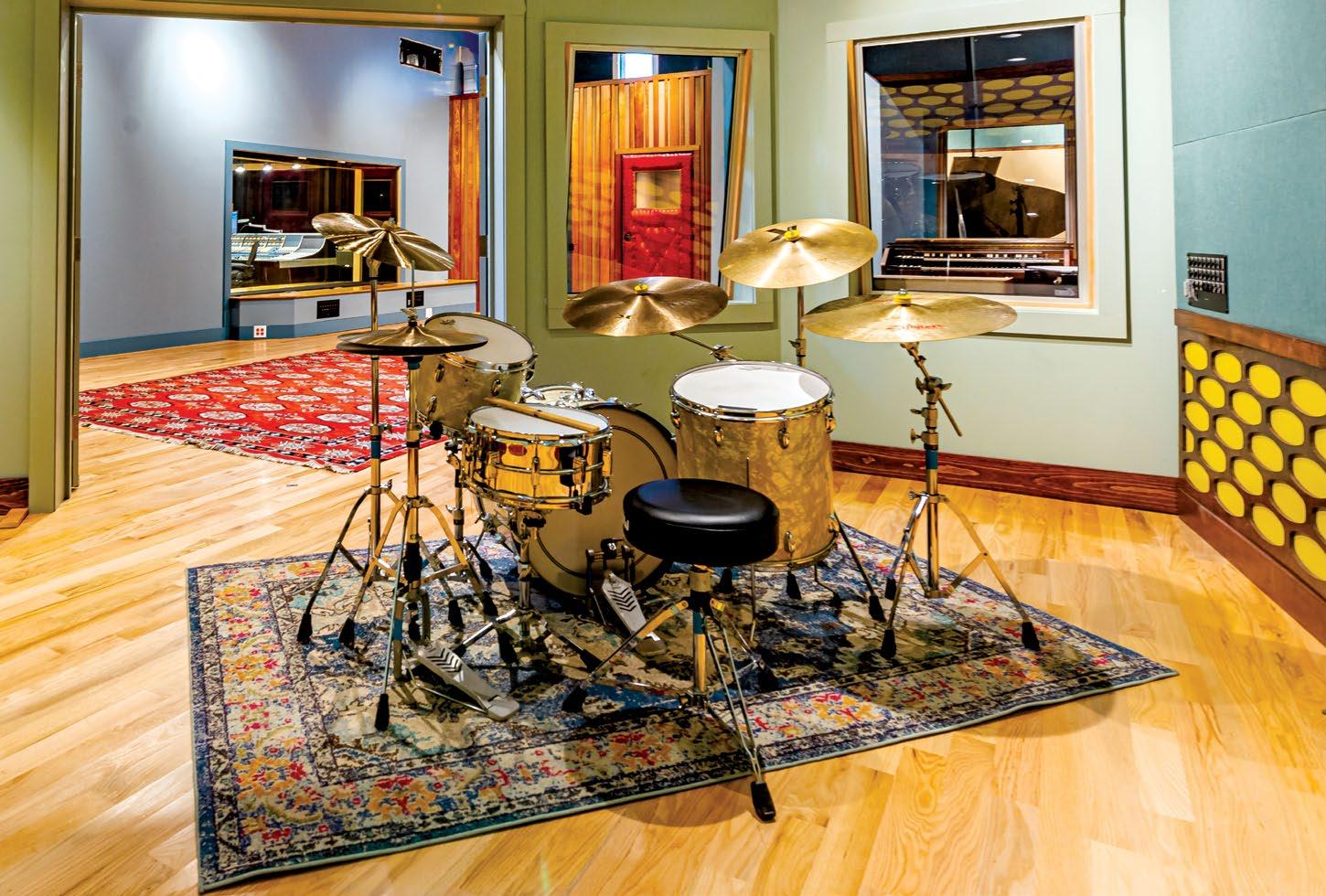
A client lounge and mezzanine round out the facility, and artist accommodations are also available on site. A mid-sized Studio B will be part of a second phase of development. Clark collaborated closely with Lupfer on the aesthetics of the rooms, as well as the acoustics.
“The prime thing they want, the whole spirit behind what they’re doing, is to do what they’ve been doing all along: to have bands in there to play together live and record,” Clark says.
WSDG-designed NovaSpace Studios is situated on the seventh and eighth floors of an unassuming corporate building in the heart of Shanghai. WSDG was tasked with creating an inspiring recording atmosphere for Shanghai’s contemporary musicians. The studio features a doubleheight live room, two control rooms, an iso booth and a lounge. Windows provide natural light, and embedded LED lighting enables engineers to tune the mood of the room by changing up the colors. Room-within-a-room construction throughout assures complete isolation between the recording spaces, as well as between the facility and the rest of the building. NovaSpace features a Rupert Neve Designs 5088 32-channel console, ATC monitors, an extensive collection of outboard gear, and mics from Telefunken, Neumann, Sennheiser and others.
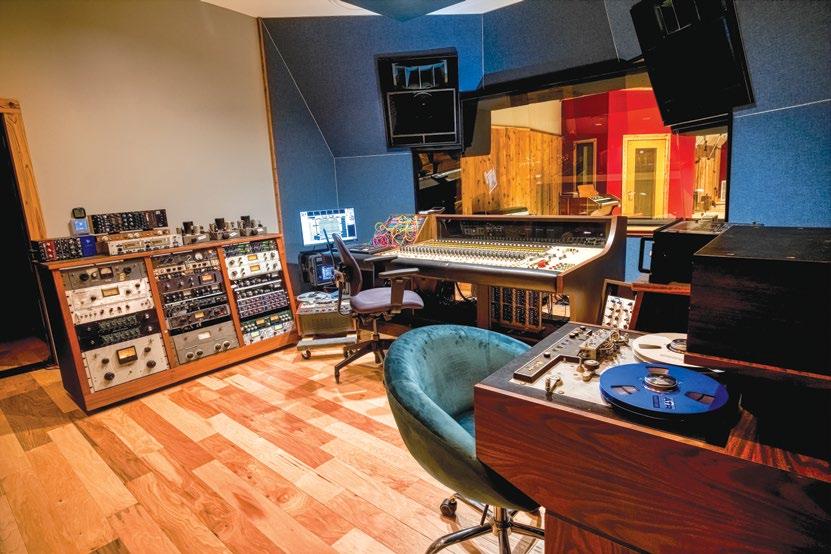
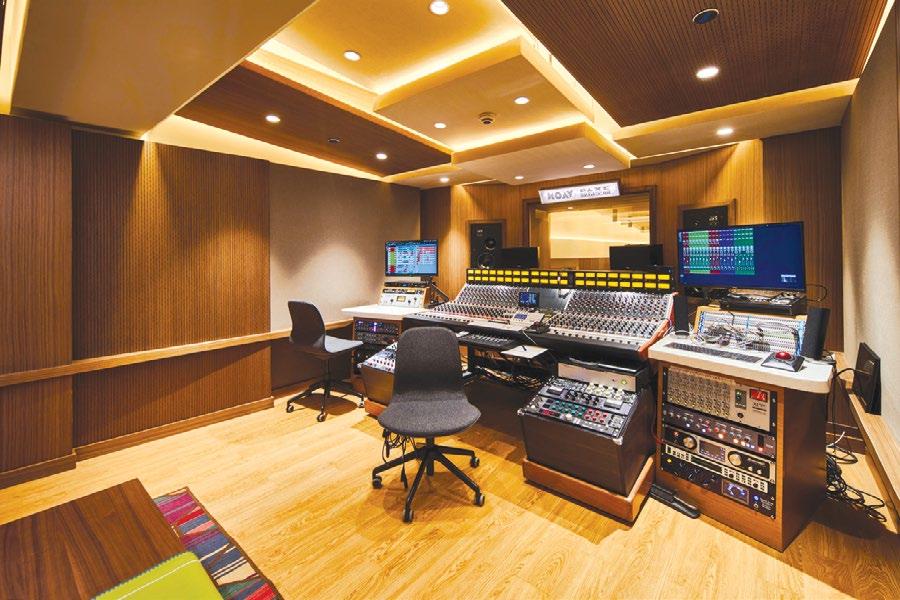
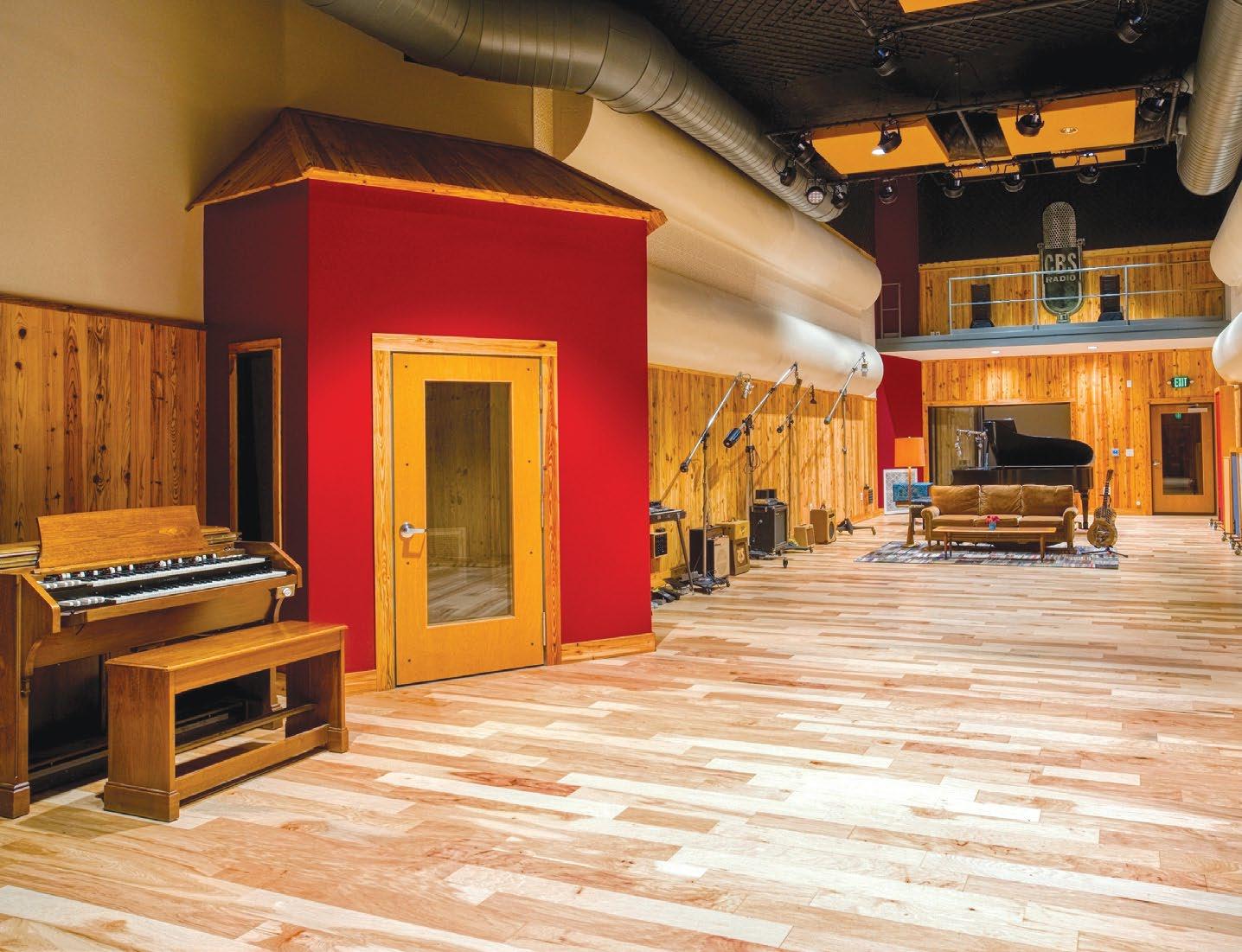

Owner/engineer Dave Tilley’s new studio was designed by Steve Durr and Matt Schlachter of Steven Durr Designs, LLC, in conjunction with Ellen Cassily Architecture. Magnetic Sound Studios was built by Chris Sparks/ Incline Construction within an early 1960s strip mall. The space was acoustically designed for Tilley to record live jazz, blues, swing, roots and acoustic music. The 1,200-square-foot live room has 19- and 28-foot ceilings. Also included are a vocal booth, a large iso booth for drum or piano recording, and a third booth connected to the control room. The live room also supports live concerts, with room for an audience of up to 120 guests. The control room features SDD-custom Altec A7 Voice of the Theater monitors driven by Spectrasonics 701 modular power amps, and a 32-channel Sphere Eclipse A console, with enhancements from Gary Barnett of Barnett Industries. Magnetic Sound also features a Memphis-inspired echo chamber, EMT 140 and 240 plate reverbs, an extensive collection of vintage and contemporary ribbon mics, and tube mic pres and limiters from RCA, Collins, Gates, TAB and others. The walls of the control room and all of the recording spaces feature amber-tinted, 130-year-old boards salvaged from Durham warehouses built in the 1890s, contributing to the studio’s warm, relaxed vibe and sound.

Gainesville, Fla.
This PhantomFocus MixRoom studio, designed by Carl Tatz and built by contractor Robinson Renovation & Custom Homes Inc., features an airy tracking room with 18-foot ceilings and a full-view exterior glass wall. The facility also offers three amp closets, a vocal booth and a client lounge. Owner Ryan Frankel’s equipment includes Tatz’s PhantomFocus PFM UHD1000 Master Reference Monitor System, a Carl Tatz Edition Dual 15L workstation by Argosy, Undertone Audio MDPI preamps, Universal Audio x8p, Dangerous Audio Monitor ST and a Hearback Pro Personal Monitor System.
Jeff Hedback of HdAcoustics designed the studios within this 4,600-square-foot facility in the Cayman Islands. Here, 2,000 square feet of dedicated recording space is complemented by a spacious lounge, meeting spaces, and a private balcony overlooking Georgetown Harbor. The studio is located on the fourth level of a mixed-use building, and Hedback’s design addressed not only sound/vibration isolation from other parts of the building, but also from a nearby helipad. Studio A offers the large control room and live room pictured, featuring exceptionally expansive water views. The control room’s geometry was modeled using BEM, ray tracing and image-source mapping methods; extensive bass trapping and the custom RPG Omniviewsor A84 diffusor array are signature parts of the studio’s sonic performance and aesthetics. The Live Room isolation shell was supplied by NM Modular Studios with HdAcoustics’ custom interior acoustics. Additional consultants on the project included architect Kozaily Designs, acoustical interiors installer Nigel Martinez and technical designer David Frangioni. The gear list includes a 72-channel SSL Duality Delta console, Genelec and Yamaha monitoring, and Pro Tools Ultimate HDX3, MTRX and Sync X systems.



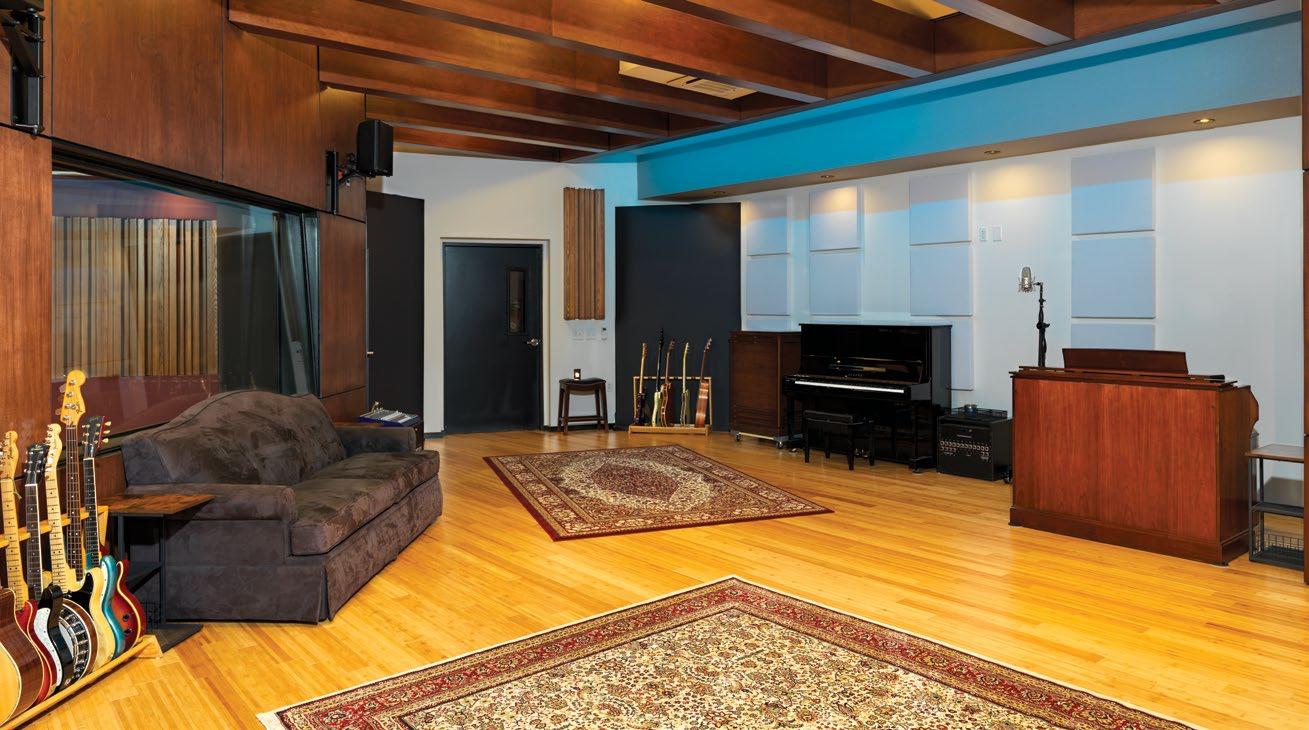

Cincinnati, Ohio
Designed by Haverstick Designs and mADE Architects & Design | Ohio, this facility boasts a 600-square-foot live room with vaulted ceilings, a vocal booth, amp room and a drum room. The recording spaces offer variable acoustics via the Flex-48 Adaptive Treatment System by Acoustical Fulfillment and curtain systems, allowing rooms to be tuned for different applications. The control room features custom bass trapping, along with clouds and diffusors by American Woodworking. Featured equipment, selected in consultation with Patrick Dennis of Sweetwater, includes PMC IB1S iii loudspeakers and Genelec 8341As with 7360A subwoofer; Universal Audio I/O, Avid Dock and S1 control surfaces; and preamps from UA, Rupert Neve Designs, LaChapell, Elysia and Slate. This destination studio, run by Brent Sheppard and his sons, Eric and Scott, is also attached to a three-bedroom home where bands can stay.

A recording refuge just a few miles from downtown Chicago, Philharmonic Studios was designed by the Russ Berger Design Group in conjunction with Melichar Architects. Owner/ producer Greg Miner’s goal was to create a multiroom facility that can handle projects in any musical genre. Studio A features an API 2448 console and ATC SCM150ASL main monitors with ATC SCM0.1/15SL Pro 15-inch subwoofers. Tracking room A, which is spacious enough to accommodate large string and jazz ensembles, features an E-CousticSystems/ pArtScience Electronic Architecture system, plus three iso booths. Meanwhile, Studio B is fitted with an ATC 7.1.4 Dolby Atmos setup and an Avid S6 control surface, making it well-suited for immersive mixing and mastering. Studio C features an SSL AWS924 board and ATC SCM25A
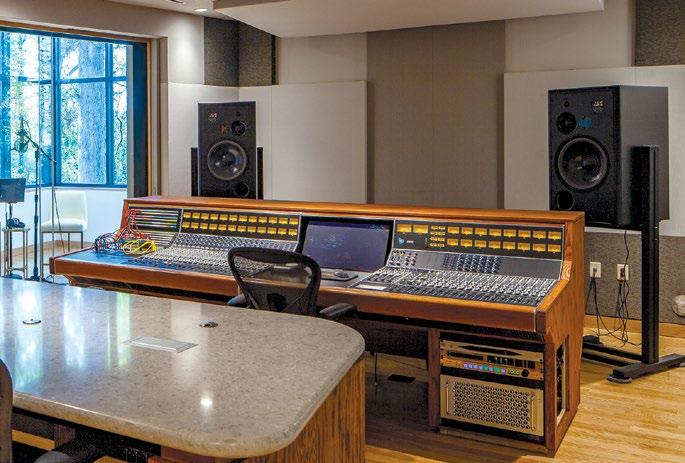



monitors, and all rooms use Pro Tools HD, making it simple for projects to migrate from one room to another.

This multiroom facility, designed by Aaron Kelley and Wes Lachot of the Wes Lachot Design Group, is Mongolia’s first fully professional recording studio. The main control room features a Reflection Free Zone design and employs RPG diffusors for sonic balance. All four walls of the live room can be quickly changed from absorptive to diffusive, adjusting the room sound to suit a wide variety of musical styles, from traditional Mongolian folk and classical to modern rock and pop music. This flexible studio is equipped with an SSL Duality Delta 48 console; monitoring via Quested VH3208 LRC mains, Quested H108 surrounds and Quested X18 subs; Pro Tools Ultimate with Burl Mothership converters; and an array of outboard gear from API, Manley, Tegeler Audio, TC Electronic, Universal Audio and Antelope.

Designed by Horacio Malvicino and Fabiola Mena of the Malvicino Design Group, Malonic Records is a Dolby Atmos-integrated studio that specializes in recording, mixing and mastering. While the live room, with its variable acoustics/wall and ceiling diffusion, can accommodate sessions of up to 10 musicians, the control room offers 7.1.4 Dolby Atmos capabilities, as well as Ocean Way Audio 2.1 loudspeakers for a variety of mixing and mastering applications. All rooms were built with room-within-a-room architecture. Headed by studio owner Nicolas Mateo and chief engineer Pablo Garcia, the facility is also equipped with Avid Pro Tools Ultimate and MTRX Studio, a wide range of outboard gear, and a variety of new and vintage microphones, instruments and synthesizers.

Carl Tatz Design and builder 2b1 Construction Inc. converted composer/engineer Chris Leon’s garage loft into a PhantomFocus 7.1.4 Dolby Atmos MixRoom Studio fitted with 11 PFM HD-1000 Master Reference Monitors. The project required careful acoustic, ergonomic and aesthetic decisions to suit Leon’s workflow in a unique footprint that includes a comfortably sized overdub booth. Studio equipment includes a Carl Tatz Edition Dual 15L workstation by Argosy, JBL Synthesis SDP-75 processor, selected outboard gear and a Yamaha C7X grand piano.

Founded by Grammy-nominated producer/engineer Maxime Le Guil and partner Victor LévyLasne, and designed by WSDG, Rue Boyer is located in a two-story building in a Parisian residential area. The studio is situated on the bottom floor, and the second floor is home to office space and a series of production suites. The centerpiece of the control room is a 48-channel E-Series SSL 4000 console that has been mounted on a motorized platform designed to lower the desk into a six-foot vault in the basement directly beneath the studio. “Disappearing” the SSL within a waterproof/ ventilated vault at the push of a button allows the control room to accommodate larger music recording sessions and/or up to 20 Mix With the Masters engineering students. Monitoring at Rue Boyer is via a Dolby Atmos surround system.

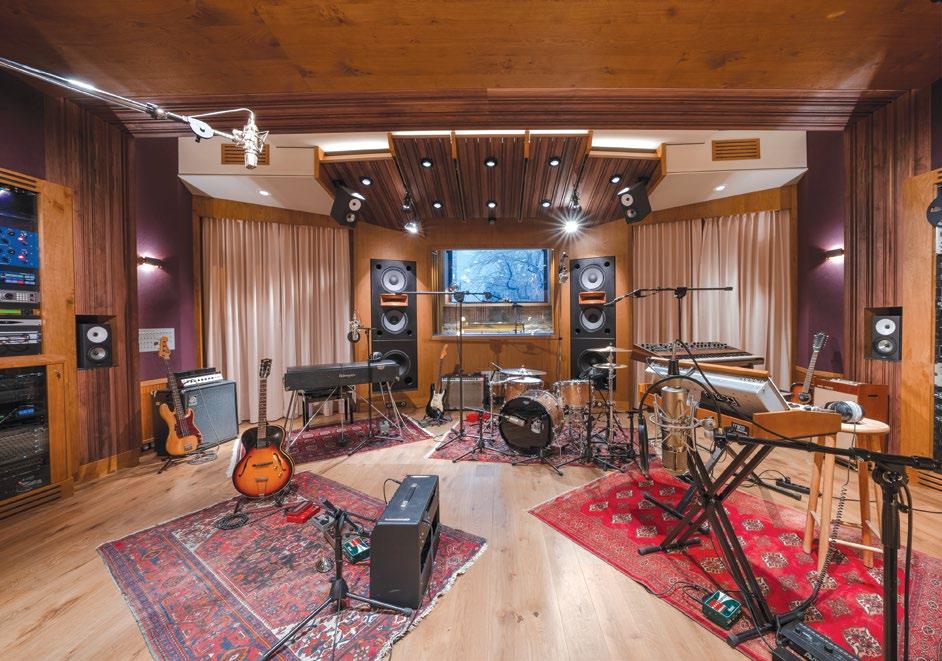




Lighthouse Point, Fla.
Singer/songwriter/musician Indy Fontaine contracted with Haverstick Designs to develop studio space for music production and collaboration with other artists. To inspire creativity, as well as high-quality recordings, Fontaine prioritized natural light and beautiful exterior views from this three-room home studio. Effective isolation from the rest of the house was achieved with a “room within a room” design and doors from Acoustical Surfaces. Custom acoustical elements were constructed by Kevin Childress at Childress Construction, including mirrored bass traps in the control room and stretch fabric panels. Skinnyfish Audio integrated all of the studio wiring, and Cam Allen of Sweetwater assisted with gear selection and integration. Selected equipment includes a 32-channel SSL Origin console, Pro Tools HDX, Black Lion and Universal Audio Apollo interfaces, ATC SCM45A main monitors with custom Bag End subs, and an extensive collection of processors, microphones and musical instruments.
Mississauga, Ontario
This studio—featuring a 550-squarefoot control room, 780-square-foot live room, two iso booths, dedicated machine room and instrument iso areas—was created by Pilchner Schoustal International, Inc. The facility offers everything necessary to suit music production and postproduction work; toward that end, the workflow is configurable to an all-analog, all-digital or hybrid signal path, and the studio systems are fully automated, including patching, to simplify recall during project changeovers. The acoustical design employs controlled reflection geometry to ensure smooth, uniform response and exceptional spatial audio performance throughout the space. Strada XR is equipped with ATC main monitors as well as a Genelec 9.1.6 Dolby Atmos system, SSL Origin and Avid S6 consoles, Avid and Lynx converters, an MCI JH24 analog tape machine, and a large collection of outboard gear, digital processing, microphones and musical instruments.

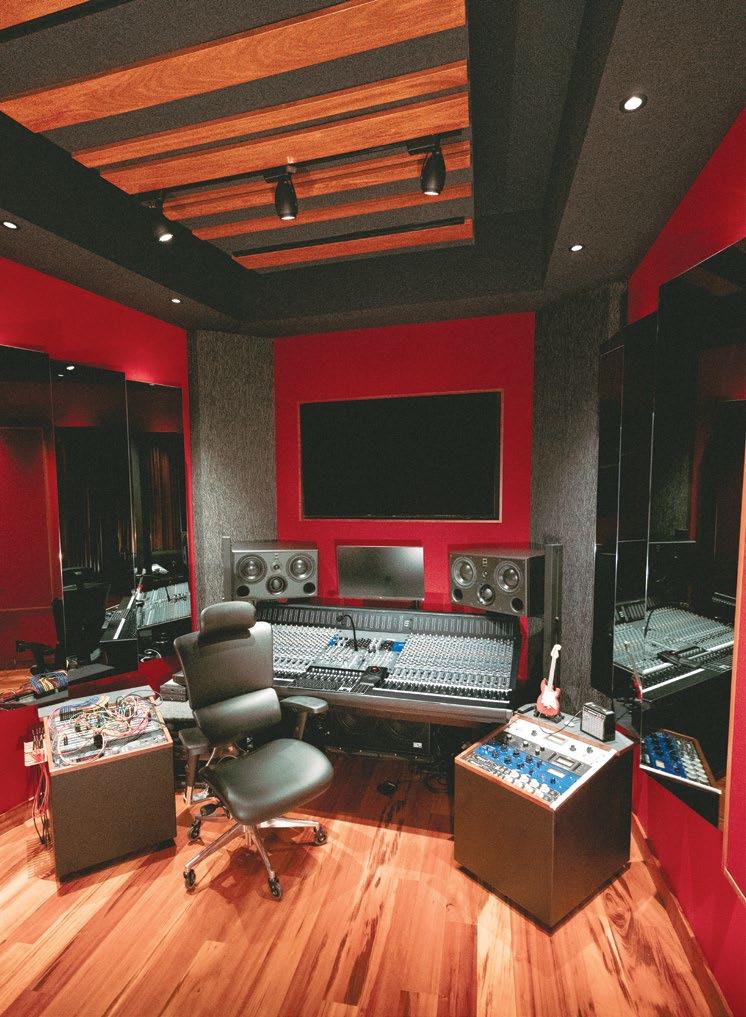
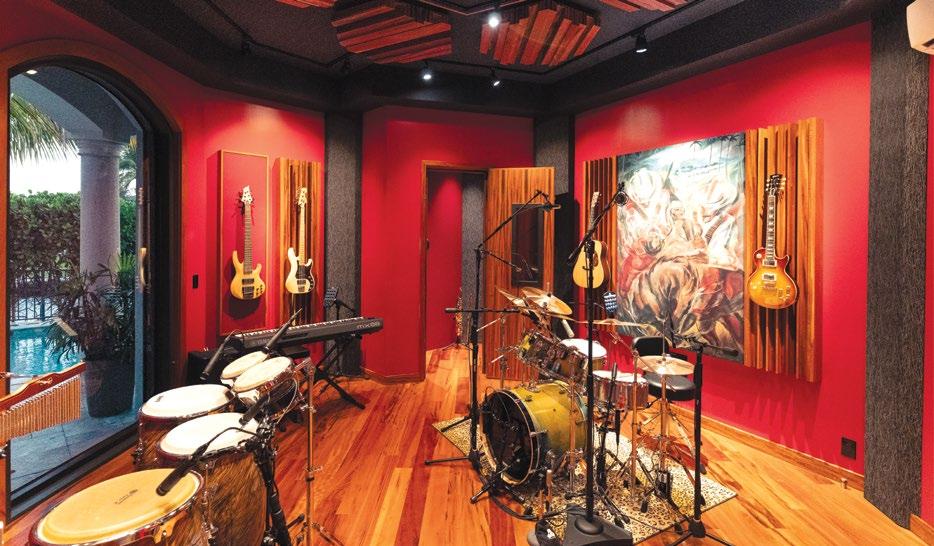
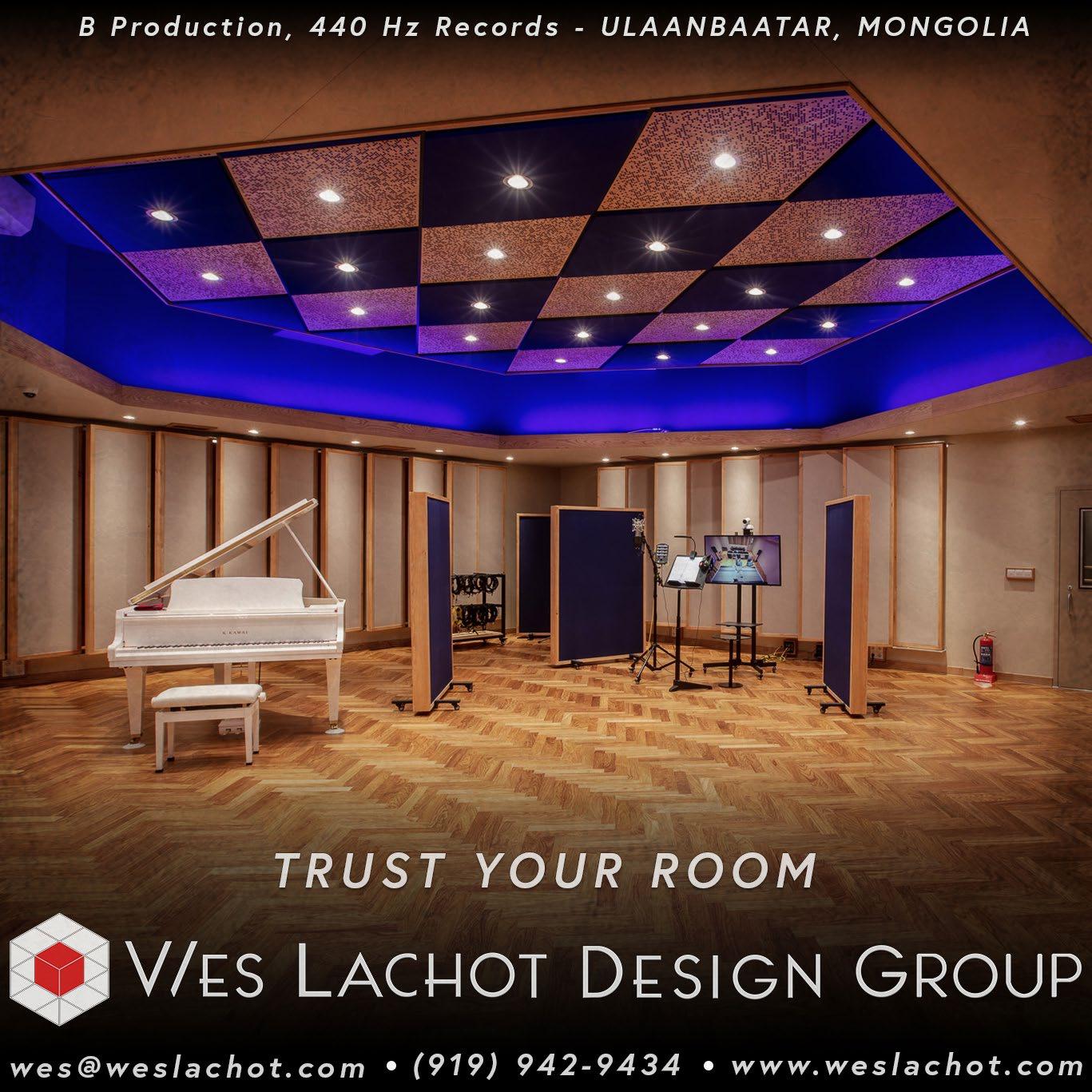 PHOTOS: Shawn Benyo
PHOTO: Martin Pilchner
PHOTOS: Shawn Benyo
PHOTO: Martin Pilchner


The centerpiece of this new recording and mixing studio is the console known as Focusrite Studio Console #5, the largest of the 10 Studio consoles made by Focusrite and one of only four that still function. The U-shaped console measures 26 feet end-to-end, and has 116 channels and 48 group outputs; it is wired 100 percent in silver cabling and offers a wealth of unique processing capabilities.

Ken Hirsch of Orphan Audio provided console restoration and installation expertise. Owner John Aquilino worked hand-in-hand with Hanson Hsu of DHDI on every aspect of the studio, from acoustics to design to aesthetics. DHDI transformed the existing building into a studio space imbued with a space-age look and feel. Using ZR Cloaks and adaptable location ZR Screens, DHDI created a sweet spot equal to the

size of the console. The room also includes ADAM Audio’s flagship S5H main monitors, Avid Pro Tools HDX and Pro Tools Ultimate 2023.3 with 64 I/O of Antelope Audio Orion 32 HD converters, 16 I/O of Focusrite Red converters, and 16 channels of Avid Purple HD converters, along with a large array of vintage, analog outboard equipment.




 PHOTO: Laurie Stephens
PHOTO: Laurie Stephens
Los Angeles, Calif.
Westlake Pro Audio oversaw the implementation of the Dolby Atmos upgrade of Fall On Your Sword Studios, working within the original surround layout designed by Chris Harmaty of Audio Structures. Updates to the multipurpose facility were implemented by general contractor Paul Reynolds. The studio, owned by Will Bates and Lucy Alper, now features a 7.1.4 Dolby Atmos system including JBL 350W High Powered 10-inch, two-way Cinema Surrounds, and an Avid S6 console that is fitted into a housing on wheels so that it can be moved easily to make space for large musical ensembles.
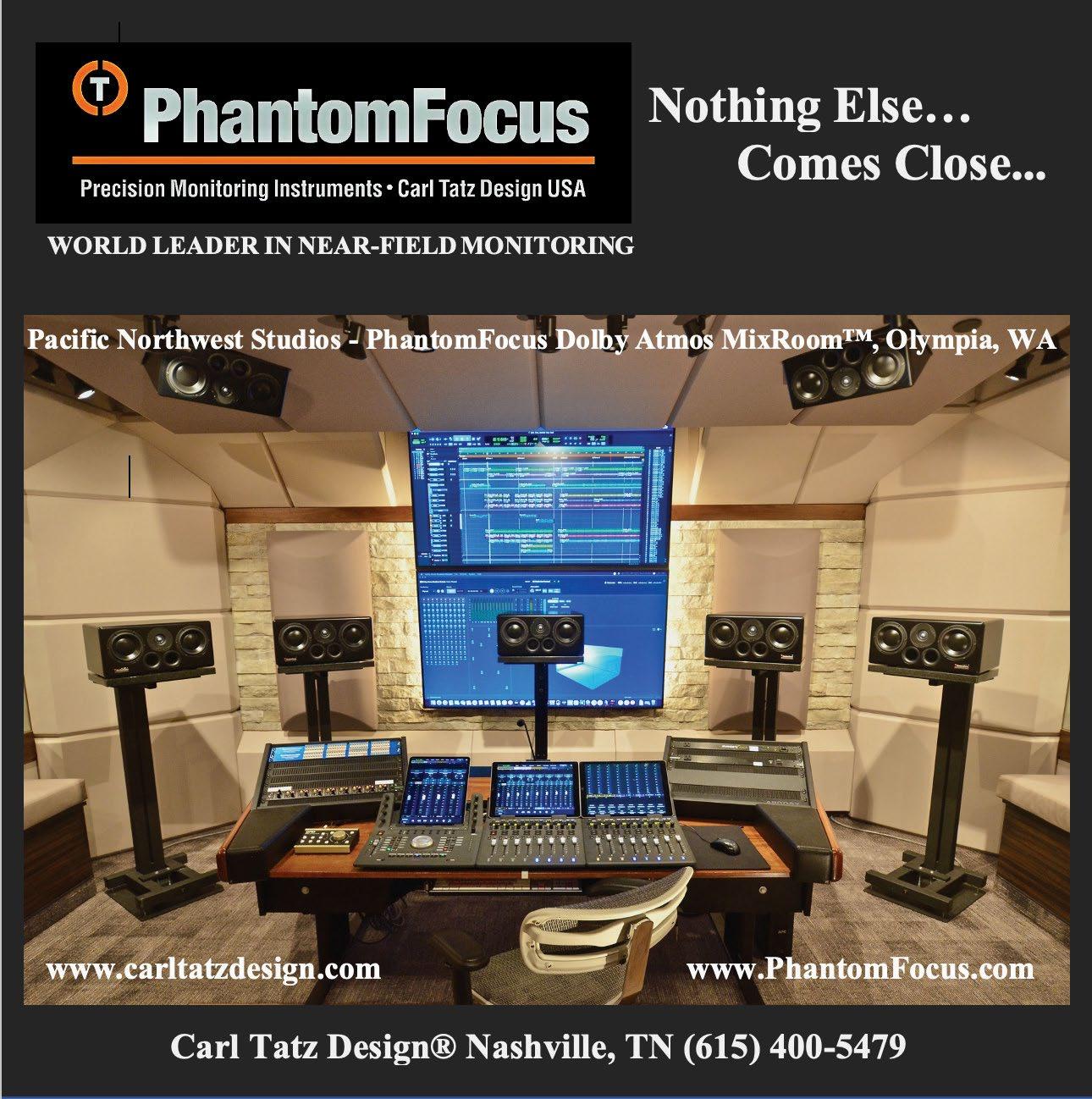
Gavin Haverstick designed this private home studio for Tim Henson, founder of genre-bending group Polyphia. Aesthetics were key to Henson, who wanted his creative space to complement the rest of his home. Haverstick Designs created a series of photorealistic renderings of different customized treatment designs for the project, including custom bass-trapping, ceiling clouds, and wall treatments to tame room-mode issues and harsh reflections, while adding to the look and feel of the space. Joe Milne of All Pro Integrated Systems assisted with gear selection and integration, and JGW Services LLC handled isolation and treatment construction. Henson’s equipment includes Genelec 8361a monitoring, UAD Apollo interface; Phoenix Audio DRS-8 Mk2, Audient ASP880 and Black Lion Audio B12a preamps, Sennheiser and Neumann microphones, and Henson’s signature Ibanez guitars.

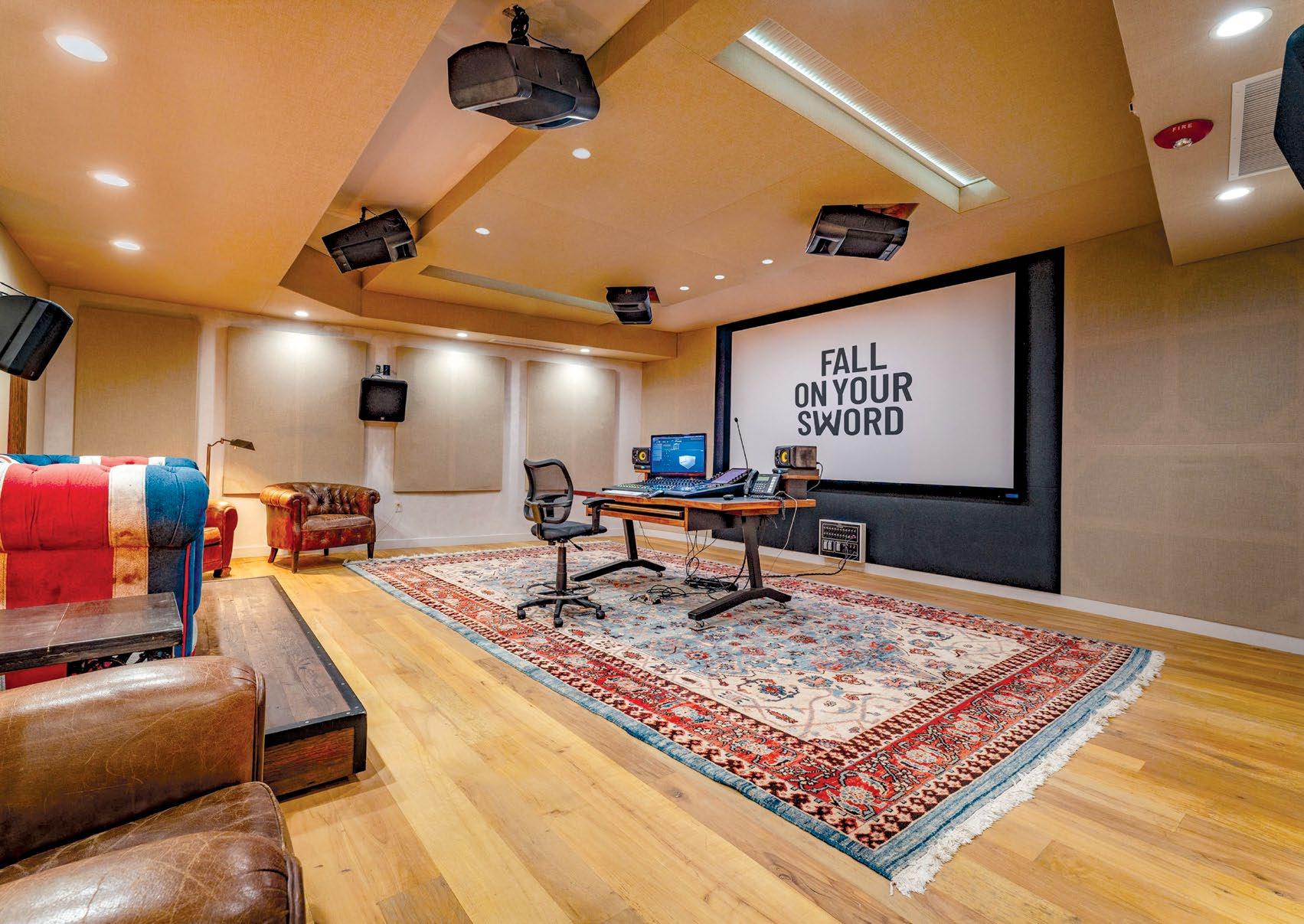
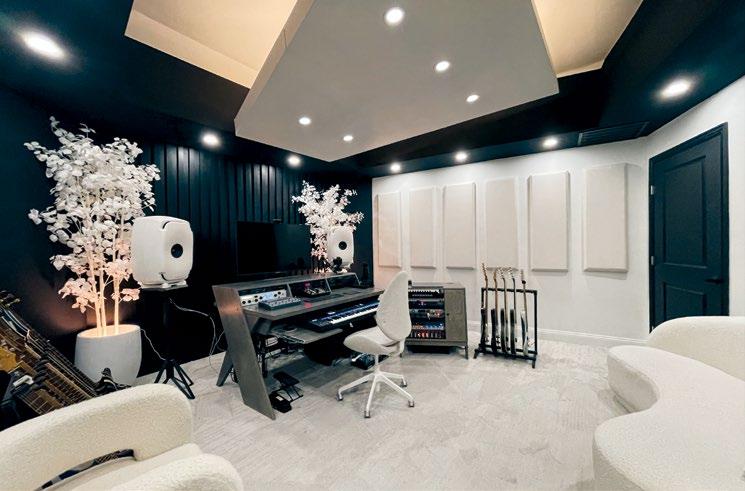
Designed by Munro Acoustics, this private studio doubles as a listening and viewing room for sound supervisor Dominic Gibbs at his home southwest of London. The room is fully Dolby Atmos HE 7.1.4 compliant and is used for sound design, effects track laying and temp mixes. Munro Acoustics’ Clive Glover says that his firm designed the facility from a concept developed by Gibbs, and worked to “integrate the surround speakers into the aesthetic to produce a room that looks as good as it sounds.” Gibbs has worked on recent films such as Operation Fortune: Ruse de Guerre, Aladdin and The Gentlemen. His studio equipment includes an Avid S3 console, Pro Tools HD3 running on a Mac Studio Ultra computer, Neve and SSL analog
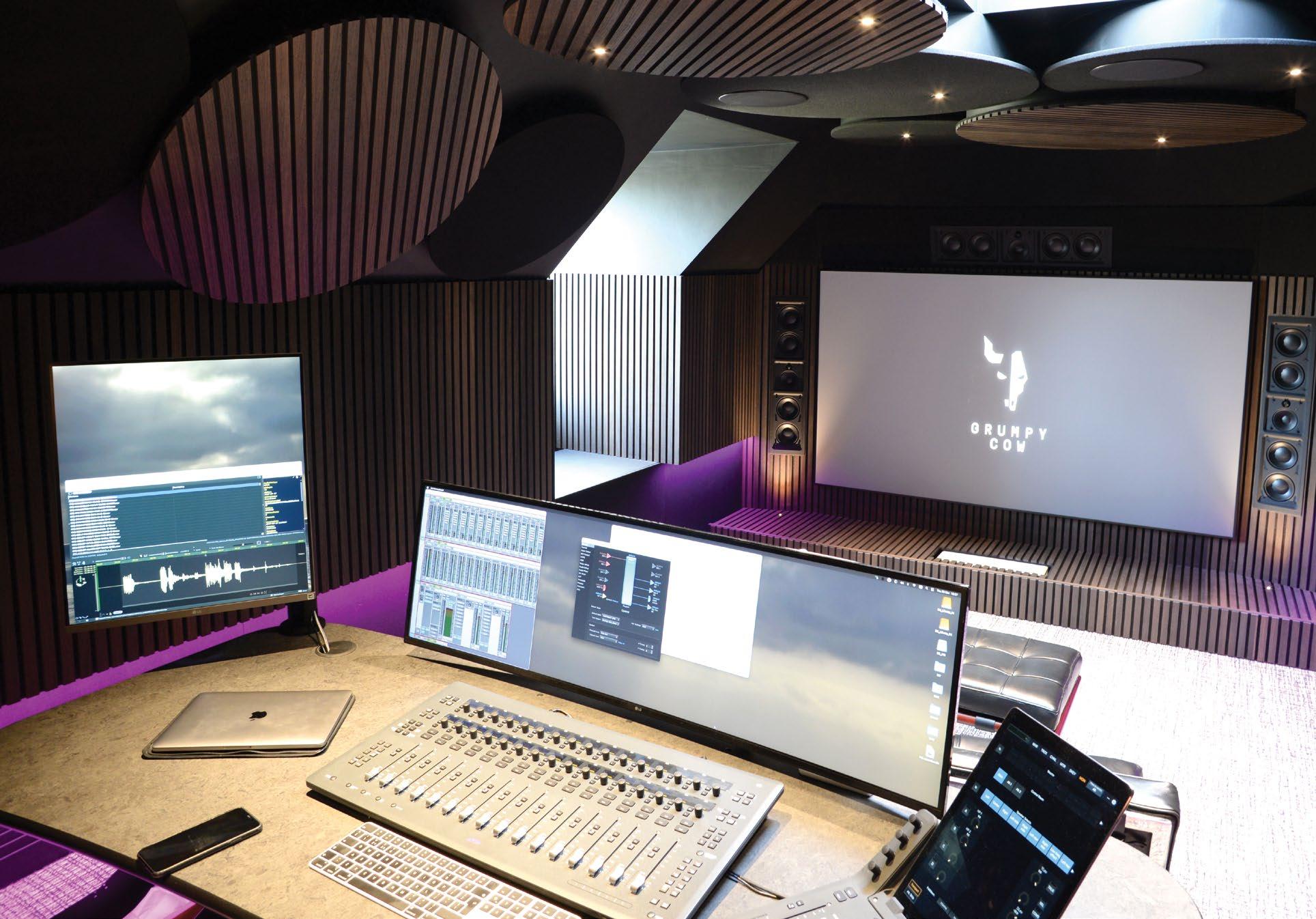
signal processing, routing through Avid MTRX Studio, and monitoring via Dynaudio custom integration speakers with a Munro Acoustics custom subwoofer and MC2 Delta 20 amps.

Las Vegas, Nev.
Dedicated to capturing hip-hop music (and culture), Culture King’s Studio features a design by Sam Berkow of SIA Acoustics (a division of RDA), with audio equipment consultation and coordination by Zoe Thrall. System design and implementation was performed by Ed Evans, in collaboration with project manager Conor Webber of general contracting firm Shawmut Design and Construction. The studio, situated within the Culture King retail facility in the Forum Shoppes at Caesars Palace, includes a live tracking room featuring a large high-STC sliding door that opens to the retail store, allowing the space to work as a performance venue for instore events. In addition, the door has electric glass that allows it to be switched from clear to opaque with the flip of a switch. The control room is outfitted with an SSL Matrix 2 console, ATC SCM45A monitors, an Apogee Symphony interface, and several RealAcoustix diffusors.
Lion Share Studios was originally designed by Carl Yanchar in 1979 for Kenny Rogers, and now has reopened in 2023 under new owner Bill Jabr. This time around, Yanchar worked with Jabr to reimagine and restore the iconic facility, known for hosting Rogers, Michael Jackson, Lionel Richie, Donna Summer, Barbra Streisand and many others. Original features of the room include live room motorized ceiling louvers and dual baffle-mounted custom walnut Augspurgerstyle monitors built by Pavel Maslowiec. As part of the refresh, new subwoofer cabinets were designed by Jabr, and the space itself was fitted with updated soffit diffusors and bass trapping, rear deep bass trapping, new floors, updated wiring with ethernet and video feeds, and a completely reconfigured, modernized workflow. At the center of the room is an API 2448 console with built-in automation and DAW control capabilities.
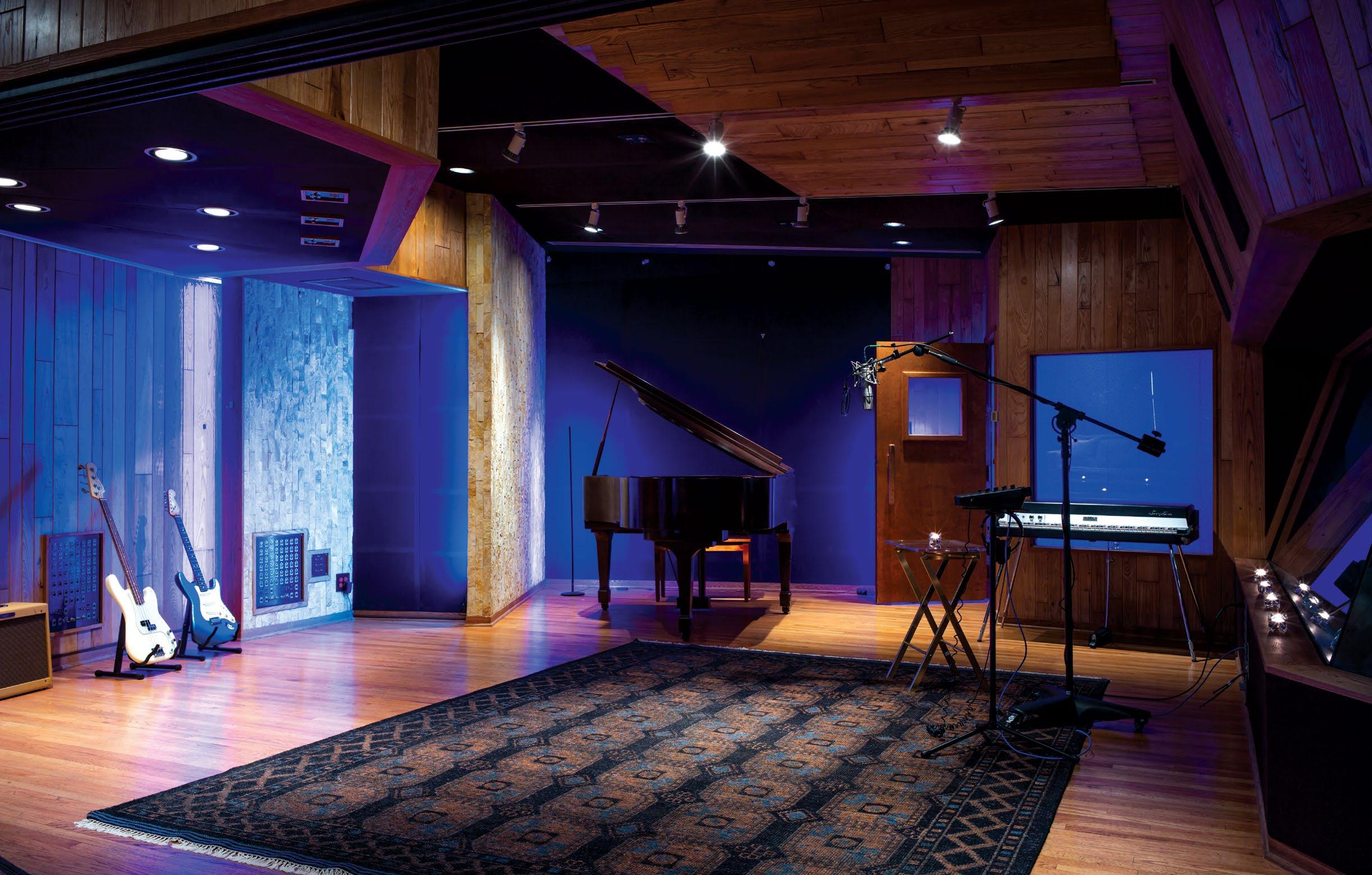
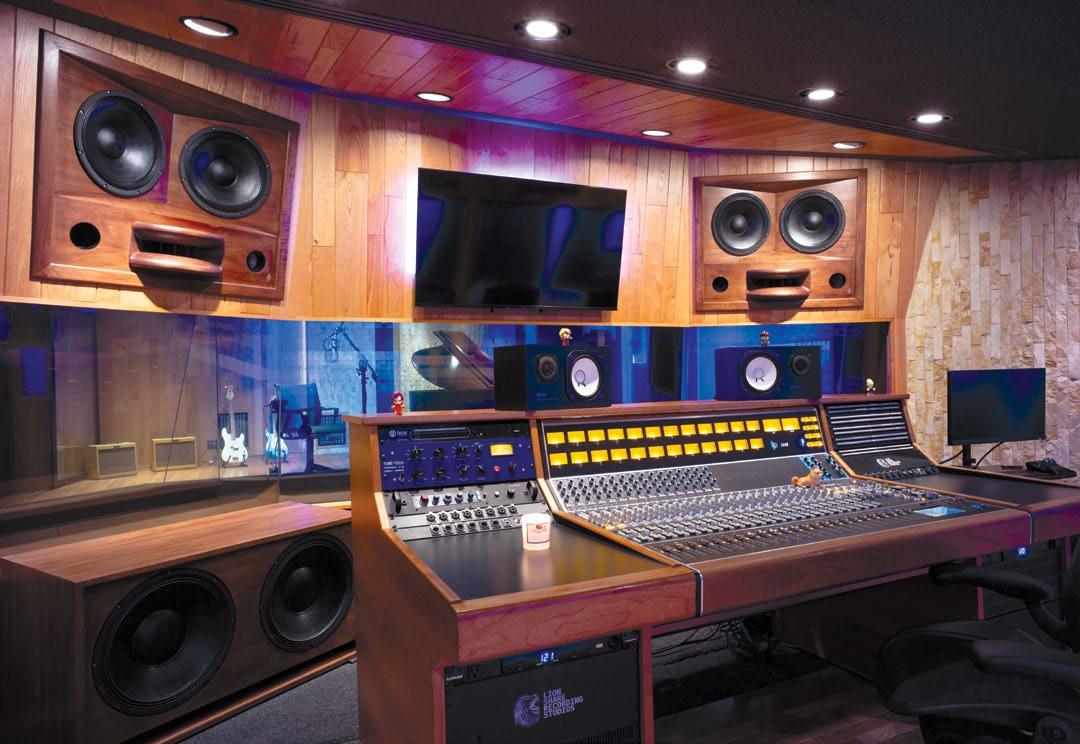




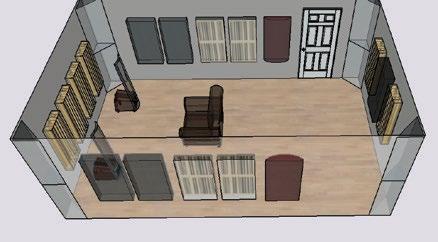





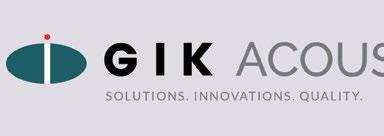



In the first week of April, Tyler Bates returned home to Los Angeles following the most recent six-week, North American leg of a now year-long tour as a guitarist in Jerry Cantrell’s band. Just prior to that, he and longtime friend Joel Richards had wrapped up the score for John Wick: Chapter 4, while at the same time Bates produced three songs that appeared in the film and on the soundtrack.
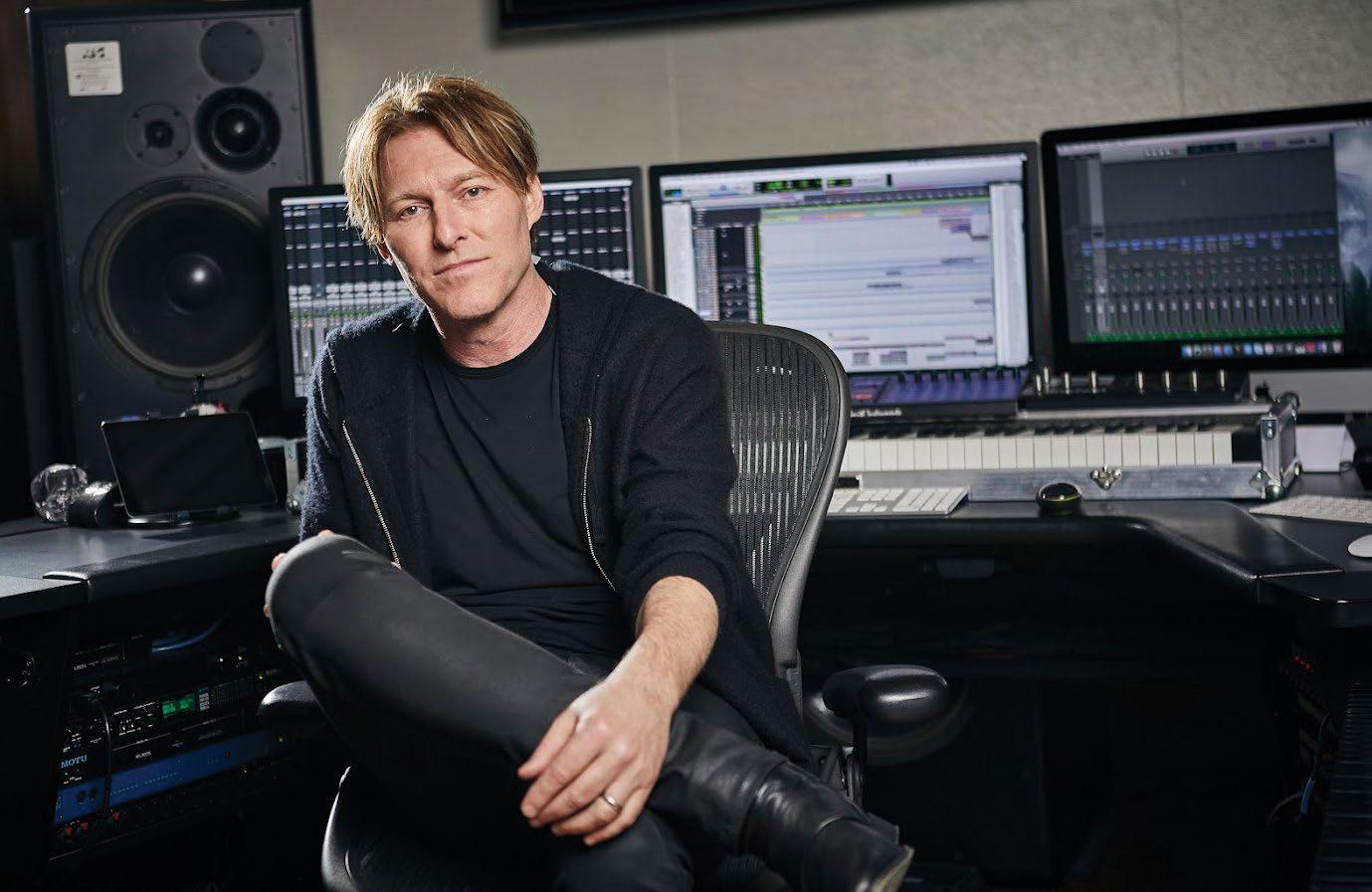
Before that, more touring with Cantrell, music for the Netflix adult animated show Agent Elvis, producing the multi-artist Dark Nights Death Metal soundtrack, producing the hot new act Starcrawler, more touring, co-writing the scores for two Ti West films, X (with Timothy Williams) and Pearl (with Chelsea Wolfe), finishing the music for a new Guardians of the Galaxy rollercoaster at Disney World, said to be the largest ride the company has ever built, and co-writing (with Joanne Higginbottom) the music for 10 episodes of the upcoming Adult Swim animated series Unicorn: Warriors Eternal
That’s just the past 18 months. Before that, he produced Cantrell’s highly personal 2021
release, Brighten, and continued writing dozens and dozens of songs with collaborators across all musical genres, most of them close friends. Some of those songs have been placed in the films and shows he’s been involved with.


Oh, and the day after getting home, he was planning to tackle final tweaks on the last two songs of the first EP by his 18-year-old daughter, Lola Collette. Bates also produced her version of the Martha & The Vandellas classic “Nowhere to Run,” which was recorded in an afternoon in New York while on tour last spring and meant to be a demo/placeholder while the directors shopped it around to up-and-coming female artists. Lola’s version struck a chord, and now appears in John Wick 4 and on the soundtrack album. Lola, too, was just returning from the Cantrell tour, where she had been performing as a vocalist each night.

“Jerry is my close friend, and it has been really beautiful to experience this tour with everybody, including my daughter,” Bates says. “Nobody is really, like, a gigging, touring musician. I was the one who selected the band, and they were all close people in my life—and they were fantastic. We finished up in Tacoma the other night, Jerry’s hometown, and it was so powerful, so great to experience that. The show was on April 1st, and the mayor even came out and named it Jerry Cantrell Day in Tacoma. I’m really happy for him. He’s a great person, great friend and an exceptional artist. This whole thing was my fault for, you know, pressing him to do a solo record.” [Laughs]
With the combination of touring, record production and scoring to picture, not to mention the travel, a family life with a wife of 35 years and two kids, and the ongoing cultural and creative shifts in music and entertainment, it all sounds exhausting. Sounds like a comingout-of-Covid explosion of musical expression, everywhere possible. Except that this is how
Bates works—across multiple musical outlets, with multiple people in the room—since moving from Chicago to Los Angeles in late 1992 and joining the rock band Pet, then six months later finishing his first low-budget score, for the film Blue Flame, co-written with George Andrian.
“I’ve always loved music—the full spectrum of music, not just rock music,” Bates explains. “I began as a guitarist, and in my young life, I envisioned myself as being a guitar player, a rock star, whatever you want to call it, but my lens for everything is through music. That’s been ingrained in me since I was young, and so it would not be fair for me to try to satiate that aspect of my mind solely through film.
“I sometimes fall into an existential crisis because the film process doesn’t satisfy me 100 percent,” he continues. “It might in the context of a particular movie, but over the course of time, I need to do other things to freshen and broaden my perspective. And with music. I need
to play music. I need it to come through my body.”
By 2004, Bates had started writing music for bigger-budget films, and over the next two years hooked up with director Zack Snyder for Dawn of the Dead, Rob Zombie for The Devil’s Rejects and James Gunn on Slither. He would go on to do multiple films with each, to be followed by ongoing collaborations with directors such as Ti West, David Leitch and Chad Stahelski, the latter two bringing him into the hyperreal, martial arts-laden, graphic-novel world of John Wick nearly a decade ago.
“The first John Wick was really just this kind of little indie film in the beginning, and before it was even edited all the way together, the two directors—Chad Stahelski and David Leitch— had requested an original song from Marilyn Manson,” Bates recalls. “I had just produced The
Pale Emperor for Manson, and his manager had just heard the full record for the first time, and he was kind of stupefied that we had done this record so fast. He asked the John Wick music supervisor to come over to my house, somebody I have known a long time, and I played them the first half of the record. He was like, ‘Jesus, man.’
“A couple of days later, the directors, Keanu Reeves and Manson came over with the music supervisor, and we listened to the record at full rock-concert volume,” he continues. “The song ‘Killing Strangers’ came up, and they were like, ‘That’s it. That is John Wick.’
“They asked me to score it the day after this meeting, but I was still on Guardians of the Galaxy, and I said, ‘You know, I really can’t. I still have to put everything I have into Guardians for the next few weeks.’ Then they asked if there was a situation where I could potentially do the movie with somebody, where we could get started with them and then hold post-production for a little bit. I called Joel Richards, who I’d known at the time for 13 years or so; he’s like a brother to me, and I knew that his sensibilities would be appropriately aligned with mine and that it was going to be kind of this hybrid rock-attitude score. We started off by writing the John Wick theme, and then fortunately it gave me the opportunity to introduce original songs to the movie, and then that became a thing for the entire franchise.
“The record comes out and it’s a big hit for Manson, and he somehow got me to agree to go out on tour. At the time, I was finishing up the first Guardians of the Galaxy movie and working on Californication. I still ended up doing 100 or 110 shows with Manson and still did a number of movies and television during that time. I was busy as hell.”
More collaborations followed, including songwriting and producing with Gavin Rossdale on the most recent Bush record, as well as cowriting with artists such as Rina Sawayama and In This Moment on the John Wick soundtrack and composers including Timothy Williams, Chelsea Wolfe, and, for the past five years, Joanne Higginbottom, who came at age 22 from Wales and has worked side-by-side with Bates ever since, starting with a co-credit on the 2018 film The Public, directed by Emilio Estevez, on through the upcoming Unicorn: Warriors Eternal
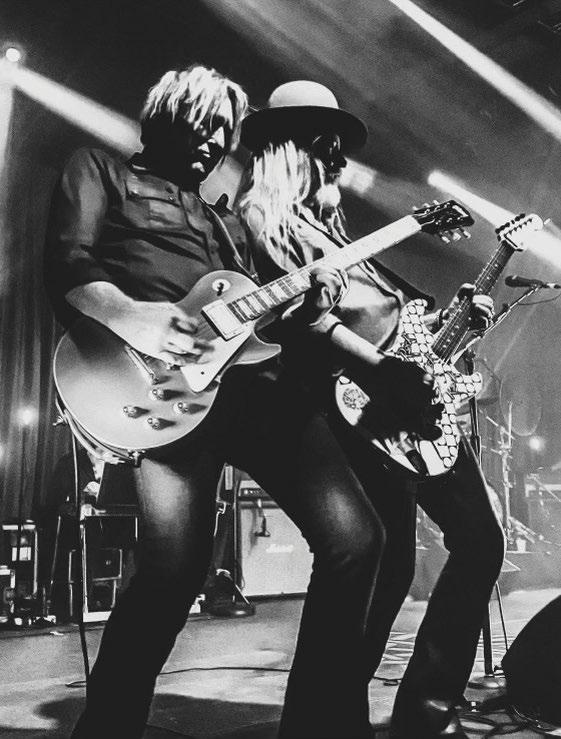
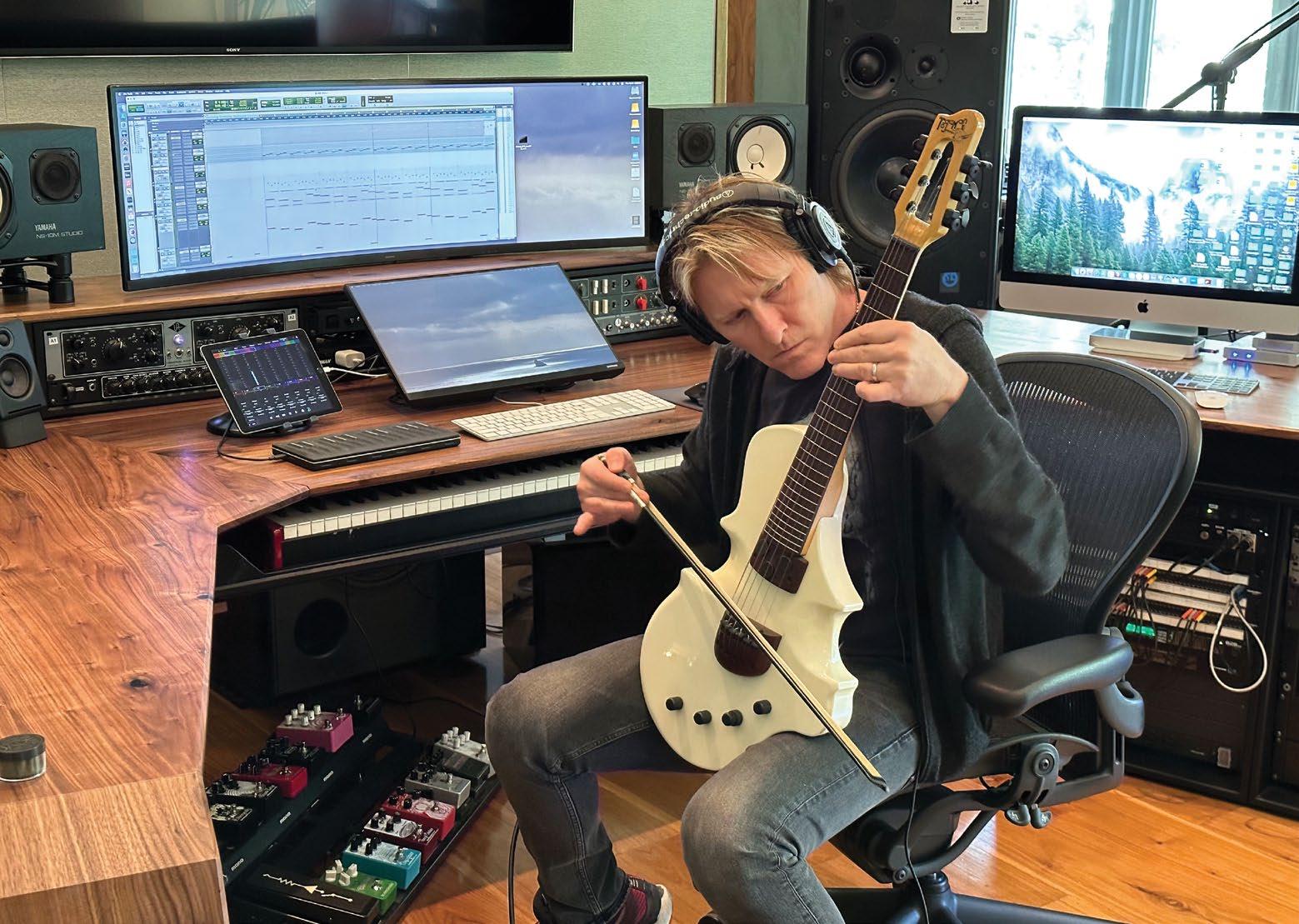
Higginbottom also works daily in Bates’ homebased, multi-room studio, where he writes, records vocals, instruments and demos, and mixes up to a point before sending tracks off to, typically, Robert Carranza for final mixing. While Bates was jamming onstage on that most recent six-week leg, the studio was going through a rather extensive infrastructure overhaul to “streamline everything.”
New wiring has gone in, powerful new Macs have been added that “within ProTools can handle a massive orchestral template of 70 or 80 instruments at one time,” and a custom desk was built to handle tabletop synths and the way Bates likes to work. Most of his work takes place in Pro Tools, “because it acts the most like a tape machine.” He also uses Logic Pro, as well
as Kontakt, Ableton and other platforms. There is ATC SCM150A monitoring throughout the facility.
He also has Bricasti and Eventide reverbs, a Chandler TG2 preamp and a Tonelux mixer. Lately he’s been enamored of the new Soyuz 1973 mic for female vocals, though he also turns to his Manley mic when he wants things completely natural. “I’m just trying to keep things simple so that my focus is really on the process and on the idea of the song, and the words,” he says.”
“I’ve really enjoyed these past 18 months,” he concludes. “In a twisted way, Covid brought with it this weird sense of liberation and freedom, once you got past the tragedies and trauma. I loved doing the record with Starcrawler. They’re incredibly talented young people and they’re awesome and they’re authentic. I’ve had a couple of collaborations now with Maria Brink of In This Moment, and that led to us writing more together. She had that song on John Wick, and I worked with them on their last EP and on their new record.
“They’re all just wonderful people, and that enriches my life and it inspires me to write more music. I get to experience how other people write music or how they go about their recording process, and that broadens me. That always gives me more fuel for the fire. Honestly, there’s not a day that I wake up where I’m not excited to see what the day brings.” n

touring amplified controller, which supports L2 and L2D with 16 channels of high-power amplification and processing. LA7.16 comes in a new LA-RAK III touring rack offering 48 channels of amplification in a Milan AVB-ready package with more than 60,000 watts of power in 9U. For hanging the new system, L-Acoustics also unveiled the new Clamp1000, which can carry up to four L2/L2D. It can also be used with Kara II, K3, or K2, supporting up to 16 K2. Using Clamp1000 users can rotate a flown line array from the ground, reducing setup time and the number of motors needed. —Clive Young
and cues to theatrical Atmos configurations. The Thunderbolt 3 Option Card brings Native connectivity to both Mac and PC machines, where users can get up to 256 channels with the interface and up to 64 channels with MTRX Studio.

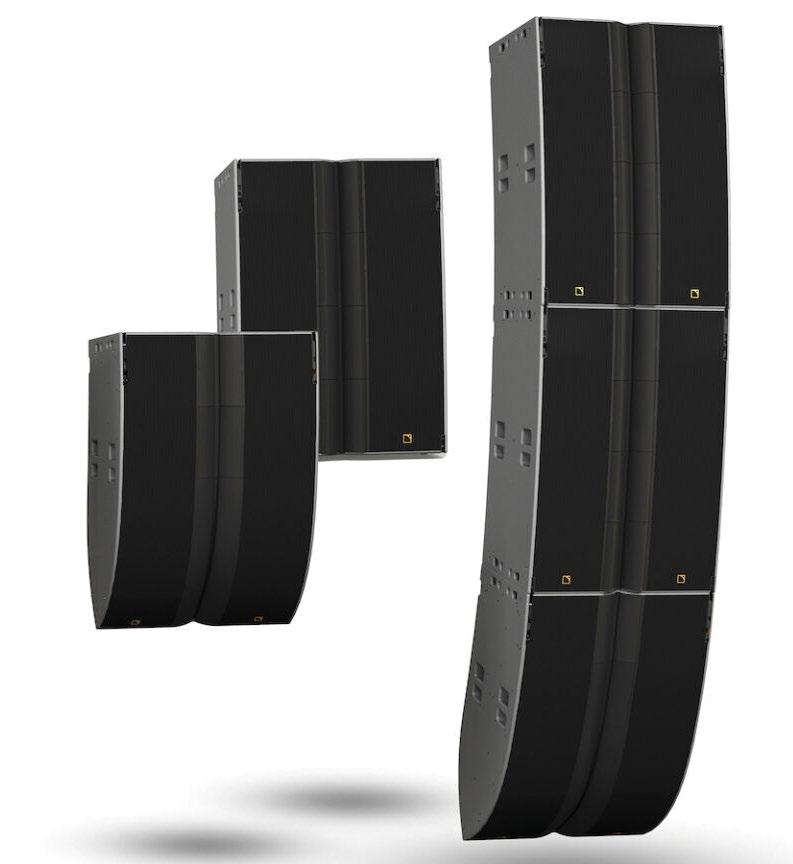

Hundreds of audio pros from top sound companies were in attendance mid-April when L-Acoustics introduced its new flagship line array, the L Series, at the Hollywood Bowl in Los Angeles. The system is based around two elements—L2 and L2D—which are essentially fixed elements with pre-defined progressive angles that between them can accommodate the seating arrangements of most venues. One L2 or L2D element provides the same contour as four K2 elements in a format that is reportedly 46% smaller and 40% lighter. Each element contains eight 3-inch high-frequency drivers with eight 10-inch low-frequency drivers, along with four side-loaded 12-inch drivers with front and back exits to deliver broadband coverage with a choice of cardioid or supercardioid patterns. L Series also employs L-Acoustics Panflex technology, providing four horizontal directivity patterns: 70° or 110° symmetrical, or 90° asymmetrical on either side. Each L2 element includes four Panflex modules, while L2D contains two Panflex modules on the top elements, and two fixed L-Fins progressing from 110° to 140° on the bottom elements. Powering the L Series is the new LA7.16 high-resolution
At NAMM 2023, Avid launched its new Pro Tools products—the MTRX II audio interface and the new MTRX Thunderbolt 3 Module. MTRX II provides users with greater I/O capacity, a larger routing matrix and more immersive

monitoring capabilities. The Thunderbolt 3 module brings MTRX II and MTRX Studio interfaces to native audio applications, which can be used simultaneously with Pro Tools | HDX. With 256 integrated Dante channels, users can connect any MTRX II audio source to any Dante network. Eight option card slots may be used in any combination with Avid’s I/O cards. Integrated SPQ processing allows users to calibrate their monitor system, providing up to 16 filters per monitor channel up to 128 channels with adjustable delay and filters. With a summing mixer of 512 x 64, the unit handles monitoring needs from simple stereo mixes
Sony brought in crowds at NAMM 2023 with the debut of its new 360VME spatial sound platform, which combines a measurement service, software and headphones to reproduce the sound field of a reference studio, allowing users to create spatial sound content from virtually anywhere. With Sony’s measurement service, creators can measure their hearing characteristics in the studio and create customized 360VME profile data. Using the profile data and dedicated software, the headphones will virtually reproduce the sound field environment of that studio, enabling users to produce spatial sound content in almost any location. Sony has partnered with three studios—The Hit Factory in New York, Gold Diggers Sound in Los Angeles and Tokyo’s MIL Studio—which are scheduled to start providing measurement services this month. Dedicated software, also scheduled for release in June, works in conjunction with the DAW and 360 WalkMix Creator, a plugin from Audio Futures, to virtually reproduce the sound field environment of the studio with headphones. Sony’s open-back MDR-MV1 monitor headphones, which the company says maximize the performance of the 360VME, likewise will become available in June.

Building on the original jam from 2010, the diminutive jamX is the latest digital audio interface from Apogee Electronics, allowing users to connect a guitar to a computer or iOS device with an interface that is small enough to fit in a guitar case compartment.
jamX adds a new feature—a built-in analog compressor featuring three presets that respond to how much the user drives the input gain. By applying compression before a virtual amp sim, players will add to their guitar tone in new ways. With three modes—Smooth Leveler, Purple Squeeze and Vintage Blue Stomp—players have the option to go from subtle to extreme. Users can stay in the rhythmic pocket with Blend mode, allowing them to record without latency. To listen exclusively through virtual amp software, turn off Blend with a click of a button. Also, it offers sample rates up to 96 kHz and ample headroom.
Ultimate Ears Pro launched its new UE Premier in-ear monitors at the NAMM Show in April, immediately grabbing attention thanks to its jaw-dropping 21 drivers loaded into each IEM. UE Premier is a premium monitor, and while it is equally meant for live sound, in-studio and audiophile use, the new model is now


UE Pro’s flagship product. Sporting a five-way passive crossover, the units feature a frequency range of 5 Hz-40 kHz; breaking down those 21 drivers, there’s four Dual Diaphragm MidLows in parallel to two Dual Sub-Lows; a Quad Mid driver provides detail; and Knowles’ proprietary Quad High Super Tweeter and UE Pro’s proprietary True Tone handle the highend. Heard briefly on the NAMM show floor, the new IEMs made a great first impression (no pun intended) when worn with standard/ non-custom tips; presumably, they will offer additional nuance with custom-molded models. Watch Mix for an upcoming full review of UE Premier in-ear monitors. —Clive Young
Black Lion Audio has introduced the PG-2R 120V Regulating Power Grid, a studio-grade regulator/ power conditioner with surge protection. The unit is designed to maintain a steady voltage of 120V within a ± 2V tolerance to ensure that

incorporates updated technology boosting the performance of its pure analog signal path with digital control, plug-in recall and automation. A new optimized limiter engine offers greater limiting control and path-to-signal uniformity: -20 dB. An improved limiter side chain with a high-pass filter—off or 20-200 Hz—and midboost filter—off or 8 dB at either 2 kHz or 7 kHz—aids delicate volume control. As far as clipping goes, the redesigned 2.0 Clipping Section handles transient material with a High or Low Soft Clip plus Soft Clip Trim. The 2.0 unit allows a user to update firmware and plug-ins through Bettermaker’s website. Also included is a black faceplate with high-colored display and well-defined high-resolution visuals to provide quick to read metering.

Fiedler Audio has announced two new plug-in sets for working in spatial music: Dolby Atmos Composer and Dolby Atmos Composer Essential. Dolby Atmos Composer comes as a set of two plug-ins (Beam and Composer), supporting all major formats, including AAX, VST3 and AU. Officially approved by Dolby Labs, the software combines multichannel audio rendering and straightforward routing, 3-D panning of tracks, and signals from DAW tracks into the 3-D world
fluctuations from a power source don’t get through to studio hardware connected to its 12 switched, filtered and surge-protected outlets. The PG-2R 120V Regulating Power Grid uses the company’s PG-99 Noise Filtering Technology and has a power absorption rating of 2,775 joules. The PG-2R’s back-panel-positioned banks of 12 switched and filtered outlets are all surgeprotected. All are divided into three groups, labeled Digital Audio Outlets, Analog Audio Outlets, and High Current Outlets. The latter two categories are time delayed to ensure that connected speakers and power amplifiers are last to turn on and first to turn off, preventing the ‘pop’ that can occur if speakers receive power at the same time as any connected sound sources.
The new, improved Bettermaker Mastering Limiter 2.0 (distributed by TransAudio Group)

of Atmos. The Beam plug-in allows creators to send their audio signals from anywhere in the session into the Composer, the home of the Dolby Atmos Renderer. Signals there can be panned to the Dolby Atmos bed and individually treated as objects on one of the 128 independent channels available, including full 3-D panning automation. With the software’s workflow, users can bring all the features of a DAW and favorite plug-ins into a Dolby Atmos mix.
Neumann has introduced the KH 120 II studio monitor, following the same philosophy as its predecessor—first released in 2010—to deliver high linearity, low distortion, little coloration and adaptability to any acoustic environment. The new edition sports DSP-controlled electronics whose crossovers avoid phase distortion caused by analog filters. The internal DSP is also said to proffer tonal consistency. It is made to low tolerances of no more than ±0.5 dB, aiding clear stereo imaging. With an eye on sustainability, Neumann engineers developed a patentpending amplifier technology that allows it to deliver up to 145 W to the 5.25-inch woofer and 100 W to the 1-inch tweeter, but only consume 17 W at idle. The new edition offers analog and digital inputs (S/PDIF). It will also be available in an AES67 variant with redundant AES67 audio network ports that are fully compliant with broadcast standards such as ST 2110, ST 2022-7 redundancy, and RAVENNA. At the same time, the KH 120 II AES67 is compatible with Dante-generated AES67 network streams.


Audio-Technica has introduced its new ATHM50xSTS and ATH-M50xSTS-USB StreamSet headsets, specifically developed to address the needs of live-streaming content creators. Both models use a cardioid condenser capsule on a
flexible boom arm, resulting in an on-the-mic vocal presence at a consistent level without background noise. The ATH-M50xSTS uses a 2-meter (6.6-foot) permanently attached cable with 3.5-mm (1/8-inch) headphone input (plus 6.3-mm [1/4-inch] adapter) and XLR microphone output. Meanwhile, the ATH-M50xSTS-USB uses a 2-meter (6.6-foot) permanently attached cable with USB-A connection (and USB-A to USB-C adapter) for plug-and-play connectivity to PCs and Macs. The ATH-M50xSTS-USB includes an A/D converter with a sampling rate up to 24-bit/96 kHz and sidetone circuitry that lets vocals be heard in the headset (with volume controlled by a dial on the earcup) for a more natural, conversational feel.
Unveiled at NAMM, the Audix PDX720 is a multi-application dynamic microphone designed primarily for studio recording of lead and background vocals, and spoken word. The hypercardioid capsule provides extended lowend response without need for active filtering, and produces gain sufficiently high to eliminate
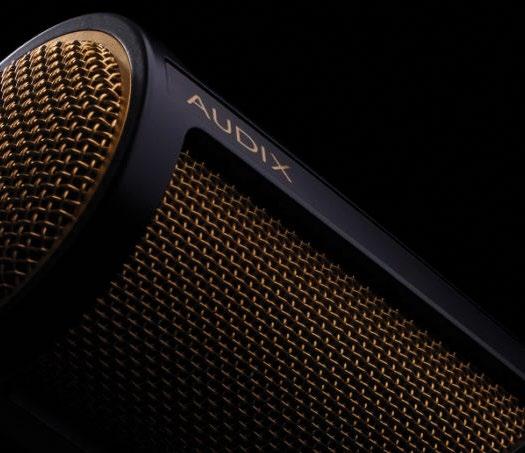

the need for preamp-boost or “lifter”-type devices. Specifications include a frequency range of 50 Hz to 20 kHz; sensitivity 1.9 mV/Pa @ 1k; maximum SPL > 135 dB; output impedance 280 Ohms. The PDX720 incorporates two three-position switches that can be used to modify its frequency response. A high-pass filter offers options of Off, 120 Hz or 155 Hz, and a presence-boost switch provides a gentle lift of 1.5 or 3 dB for increased clarity in the vocal range while avoiding harshness.
Sound Particles has introduced a 3D synthesizer, SkyDust 3D, a virtual instrument with full 3D audio support, fully integrating the Sound Particles 3D engine with a polyphonic synthesizer. It enables an operator to, for example, use MIDI aftertouch to control 3D position, or EGs that control the movement of each note, or an LFO to change the elevation of notes, creating an arpeggio that moves through space. The software synth supports more than 30 output

formats, including stereo, 5.1, 7.1, 7.1.2 (Dolby Atmos), 9.1.6, Ambisonics (up to 6th order) and binaural (3D sound over headphones), among many others. SkyDust 3D is available on the Sound Particles website in a spatial version and stereo-only version.
any full-range cabinet (Yorkville Sound’s YXL line includes options for 10, 12 and 15-inch full-range speakers).

iFi Studio is a new UK-based audio brand that debuted last month with a collection of converters (D/A), interfaces, controllers and headphone amps aimed at pros. The launch products include Pro iDSD Studio, a flagship interface and controller with high-end D/A conversion; Pro iCAN Studio, a headphone amplifier compatible with any headphone sensitivity; EN One Studio, a compact D/A converter with high-resolution file handling;
At the 2023 NAB Show, Lawo unveiled a new addition to its audio production console range, the mc²36 xp. Physically identical to the mc²36 MkII and true to its “xp” moniker—no onboard processing—the new console supports up to 256 DSP channels and offers Lawo’s audio quality, IP network and processing redundancy, and eligibility for a multi-slice console array based around a single A__UHD Core processing unit.
Canadian pro audio manufacturer Yorkville Sound has released the YXL18SP powered subwoofer— the latest addition to the YXL Series of powered cabinets—aimed at the DJ and musician markets.

The first subwoofer in the YXL lineup, the 15-inch YXL15SP, was released in 2022. Providing 1,000 watts, the YXL18SP is loud for its size. Weighing in at just over 70 pounds, the YXL18SP remains transportable and able to be maneuvered by users as needed to achieve the desired sound coverage. The new powered subwoofer can be used with
ZEN CAN Studio, a matching headphone amplifier and controller; and the Gryphon Pro Pack, a personal “belt-pack” amplifier for IEMs with a built-in high-resolution D/A converter. iFi Studio is distributed by American Music & Sound in the U.S.
Apple has launched Logic Pro for iPad, available as a subscription on the App Store for A12 Bionic chip iPad models or later that have iPadOS 16.4. Logic Pro for iPad supports roundtrip capabilities, allowing users to move projects between Logic Pro for Mac and iPad. iPad users

can export their finished songs in a variety of formats, as well as individual stems, and also import projects created in GarageBand for iOS. The app includes software instruments and controls, and can record using the five builtin mics on iPad Pros. A new Sound Browser displays all available instrument patches, audio patches, plug-in presets, samples and loops in a single location. More than 100 instruments and effects plug-ins are included. The app includes a full-featured mixer, complete with channel strips, volume faders, pan controls, plug-ins, sends and automation.


DiGiCo’s new flagship console, the Quantum852, features redundant processing engines, each powered by five seventh-generation FPGAs and next-generation SHARC DSP processors. As a result, it can handle up to 384 mono channels, with 192 Aux / Sub-Group busses, plus LR / LCR / 5.1 Master busses. It comes with a 64 x 64 Processing Matrix, 36 Control Groups, two Solo busses and 64 FX Rack slots. Also onboard are 48 Graphic EQs, 384 Nodal Processors, 128 Mustard Processors and 32 Spice Racks. The desk features 78 touch-sensitive, 1000-nit LCD screens for full daylight operation—three 19.2-inch meter bridge screens; a trio of 6.8-inch control screens for bank and layer switching; three 21.3-inch main screens; and 69 1.3-inch worksurface screens.
The desk comes with Ultimate “Stadius” modular LOCAL I/O, with each of the three cards providing four Stadius Mic-Pres, four Stadius Line Outputs and two Bit Perfect AES I/O. On the back of each engine are eight single or four redundant BNC MADI ports, Word Clock, AES Sync and Video Sync inputs, Dual USB 2.0 sockets, a SuperSpeed USB 3.0 socket, 4k DisplayPort Overview Out, 5-Port 1Gbps network switch, Dual DMI slots, and Waves SoundGrid port and Optocore inputs as standard, with space for an optional second Optocore loop. n
In my previous reviews of Austrian Audio’s OC818 large-diaphragm condenser and CC8 small-diaphragm condenser, I noticed a few trends: high SPL handling, natural dynamic capture and frequency response much closer to “flat” than “colored.” In this review, I worked out the company’s new dynamic mic and two condensers, each with their own quirks, but largely following the trends previously identified.
Much like the flagship OC818 (and similar, yet simpler, OC18), the OC16 is a large-diaphragm condenser with a “flask/cartridge”-shaped form-factor, but only a cardioid pattern and a switchable, second-order high-pass filter at 40 or 160 Hz. The CKR6 capsule is like the 818 CKR12, but with a single diaphragm. SPL handling is 148 dB, with 20 Hz to 20 kHz response and 14 dB of self-noise. The OCS6 suspension mount, OCH8 clip and a soft-shell carrying case are included.
The OC7 is a small-diaphragm cardioid condenser with a “slimbody and swivel head” design for capturing instruments by allowing for convenient positioning with 220 degrees of head rotation. In addition to a second-order HPF at 40 or 80 Hz, the OC7 has a -10 dB pad. Frequency response is stated from 20 Hz – 20 kHz, with SPL handling at a whopping 154 dB and 19 dB of self-noise. The OCH8 clip and case are included.
The OD5 looks exactly like the OC7; it is an active-dynamic cardioid mic and requires phantom power, but provides a bit more output, helps encourage stability with long cable runs and allows an HPF. The filter here is a standard, moderately sloped, secondorder type at 120 Hz, but also has a resonant filter at 80 Hz with a slight bass-bump before sloping off at second order. A -10 dB pad is switchable, with frequency response from 20 Hz – 18 kHz, SPL handling of 151 dB and 21 dB of self-noise. The OD5 ships with clip and case.
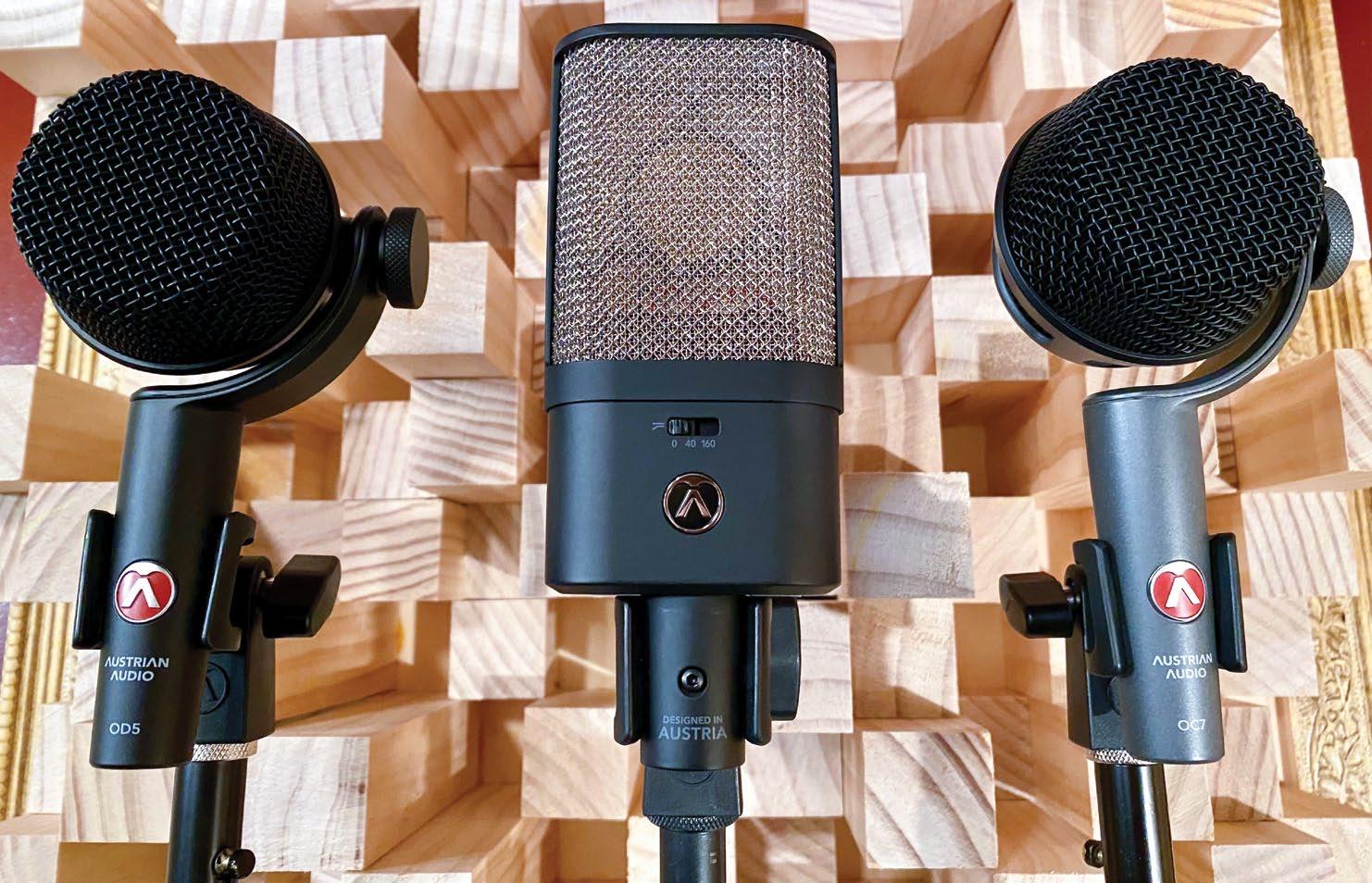
I had the Austrian trio in my studio for a few months, and I put them up on every single session, knowing that I could trust them to perform, even in sometimes harried conditions—and perform they did, as I never found any inappropriate applications or encountered any overload or distortion. Particularly, I never once required the use of any of the mic’s pads; all SPL was handled even as I miked drums, loud guitar cabinets and percussion. When it comes to bulletproof, volume-munching capsules (and robust electronics), I’m not sure anybody can keep up with Austrian Audio. Conversely, I sure did need the HPFs, as all three of these mics reach way down deep. The OC16 has plenty of extension and requires filtering for most anything but kick or floor tom, but the OD5 has that entirely different dynamic-mic-kind-of-bottom—it punches hard, and that’s not even counting the resonant HPF setting that gives you even more punch and a bit of thumpy hype. The OC7 and 16 both have hot outputs, with the OD5 typically needing 25 percent more gain despite its active circuitry. None of the three seemed noisy, except for a tiny bit on the OD5 with lots of preamp gain on very quiet sources (i.e., finger-picked guitar).
I started out with trumpet and found the OD5 and OC16 made a nice pair, with ample but not harsh top-end from the 16 and some warm, comforting low-mids from the 5; with both equal in output level, no EQ was required other than HPF’ing in the mix.
The OC16 did a fine job on both drum overhead (mono, center position) and snare top (SPL was no problem with a medium-hard hitter), with an absence of harshness and no EQ required other than HPF’ing (in retrospect, I could’ve used the mics’ filters). The OD5 loves snare bottom, with nice chesty lows, no shrillness to the “snap” and a hotter output than my typical dynamic.
My usual pairing on close-miked electric guitar is an LDC and a Shure SM57, so I substituted the OC16 and the OD5 and got predictable results: no pads needed, complete frequency coverage, smooth articulation and a little high-mid mix EQ to create the tingly sizzle that the 57 usually provides.
Acoustic guitar found both the OC16 and the 7 getting me very nice sounds, with requisite detail, open dynamics and a lack of nastiness, up close to the neck or close to the bridge. I tried the OD5, too, but wasn’t feeling it, as it seemed a little congested and noisy for the delicate job.
Vocally, the OD5 will catch you off-guard, with a surprisingly nice chest mids-top balance that’s kind of like an E-V RE20 or Shure SM7B and sounds nice on loud rock singers (like many dynamics, it tames mouth noises and harshness). The two HPF filters make for nice options depending on your needs. The OC16 seems slightly low-mid carved on male voice until you
COMPANY: Austrian Audio
PRODUCT: OD5, OC7 and OC16 Microphones
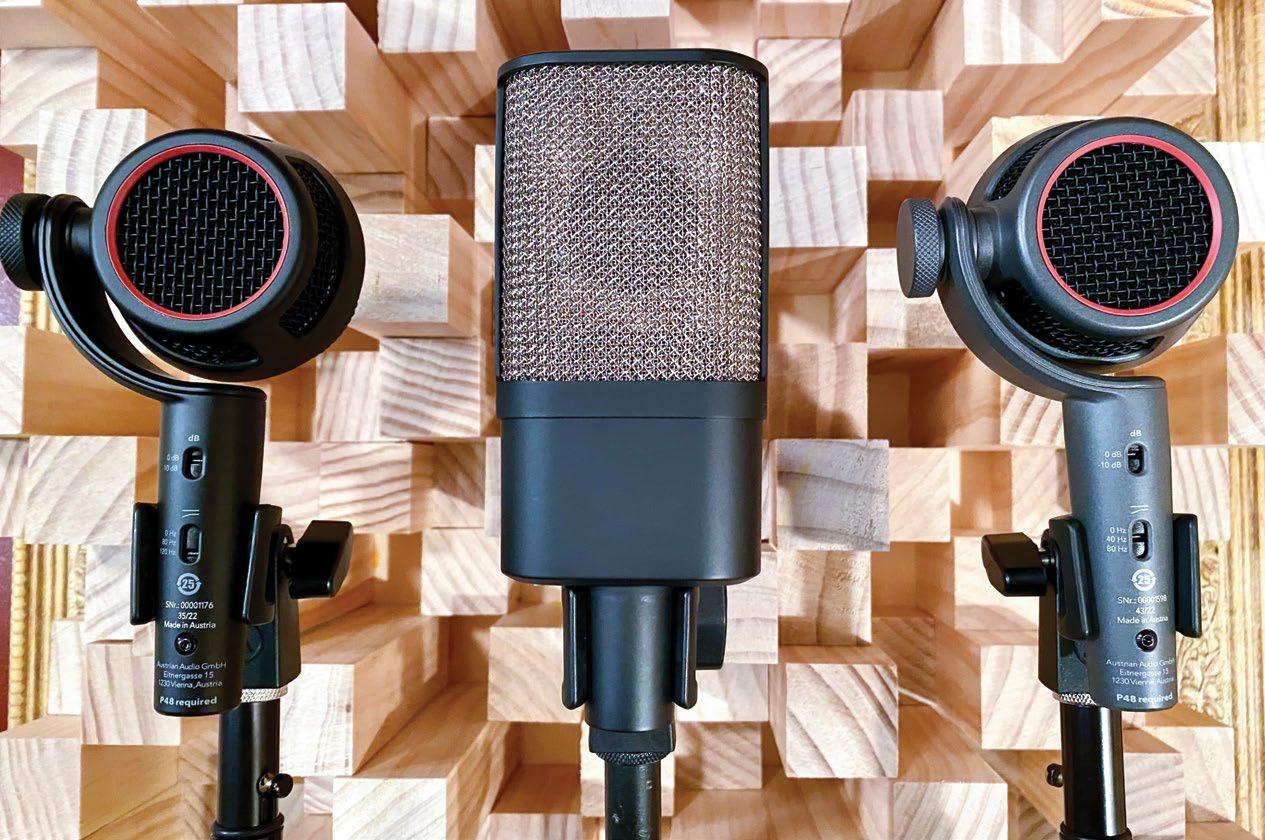
WEBSITE: www.austrianaudio.com
PRICE: OD5, $299; OC7, $519; OC16, $399 (all MAP)
PROS: Superb SPL handling, low noise, quality construction, mostly flat/neutral frequency response, versatile in application (especially the OC7).
CONS: OD5 can sound congested on acoustic guitar.
try the filters; 40 Hz balanced the bottom of the spectrum more smoothly, and 120 Hz made for a crisp and articulated modern vocal sound.
The real surprise, though, was the OC7, which sounds quite nice on male voice, with a very musical low-end translation, no mid-subtraction and a super-sweet top end. Sure, it’s a little sensitive to plosives, as SDCs tend to be, but if you use a good pop filter or go easy on the Ps, you’ll be okay with the mic’s 40 Hz filter.
Beyond actual session work, I did actually do some proper tests with all three transducers, which I’ll briefly summarize. All three handled the rigors of 16-inch floor tom without issue, but the OC7 had the only “no-EQ, perfect balance.” All three handled snare without overload or pad, although the OC7 had that elusive balance and detail that made rolling patterns ideal in balance and complexity.
All three struggled as I hit them with excessive vocal sibilance and plosives without a pop filter, but none were out of the ordinary or problematic in the slightest. In general, I have found all of Austrian Audio’s mics handle sibilance gracefully; maybe it’s the ceramic capsules or the membrane tensioning.
The ever-revealing test of tambourine was an eye-opener, and a reminder to never assume much with mic selection. The OD5 was delightfully punchy, with an ideal amount of zing and bite, maybe a little 2k-ringy, but this was a very useful tone. The OC7 was again supremely balanced if not quite as punchy. Unexpectedly, the OC16 seemed kind of toppy, with almost too much sizzle and a thin, lean bottom end that
didn’t keep up with the others. Finally, I tried the most demanding test, piano, with curious results. The OD5 wasn’t a great choice here, but dynamic mics seldom are. The OC16 sure did capture the fullness, but seemed a little uneven through the mids, while also a bit cloudy on top-end detail. The top performer was the OC7, which grabbed transients beautifully, was just a tad shy of bottom end and had an openness up top that was quite beautiful. Classical pianist Alex Mauldin commented, “I can hear the airiness only with the OC7 and its much more lively sound.”
With superb quality construction, excellent fit/finish, wide frequency response, natural dynamic reproduction and fantastic highvolume handling, this trio from Austrian Audio fit my expectations and showed just how consistent the company’s line of microphones is. These folks know what they’re doing, and they’re doubling down on the above-mentioned qualities and traits for their entire line.
The OD5 has a classic dynamic mic sound, which is aided by active electronics, a swivel head, its high-pass filter and excellent SPL handling. I won’t hesitate to recommend it on drums, speaker cabs, loud vocals, horns and anywhere you would reach for a MD421/RE20/SM7B.
The OC16 is exceptionally priced and a suitable “starter mic” for those wanting an OC818 (or 18). The OC16 doesn’t quite have the linear mids, or pristine “truth,” of its siblings, but with careful use of its filters, it can be a fine vocal or instrument tool for those who don’t expressly need multiple patterns.
The OC7 is the darkhorse that I’ll now consider a frontrunner, with its inherent flat tonality (flat in a very good way), versatility of placement and wonderful SPL handling. For those who still record acoustic instruments (as well as vocals), I have to recommend a pair for stereo applications. I would imagine a pair of OC7s could handle just about anything in just about any stereo technique (excluding Blumlein and Mid-Side, obviously). They are a little pricey, but they earn every penny with their flexibility and quality. n
Continuing the KIT Plugins tradition, the company has released BB N73, another virtual version of a piece of legendary Blackbird Studio hardware—in this case, the
Neve 1073, one of the most iconic and imitated channels in recording history.
The term “British Sound,” some say, originated with the 1073-equipped, 28-channel A88 console that Rupert Neve & Co. delivered to Wessex Sound Studios in the summer of 1970. This was the first desk to be fitted with the Neve model 1073 channel amplifier/equalizer module, a class-A, solid-state preamp with transformer-balanced inputs and outputs. The modules (which were never designed to work outside of a desk) have risen to legendary status over the past five decades.
Blackbird Studio’s John McBride owns a massive collection of the modules, and he hand-selected his favorite 12 to be part of the KIT Plugins N73 modeling. The modeling (accurate from 10 Hz to 96 kHz) incorporates the original module’s channel modifications, cabling and component aging, ensuring the plug-in accurately captures every nuance of the sound of Blackbird’s hardware. As with other KIT Plugins products, the BB N73 supports both mono and stereo signals, and is available in VST3, AU and AAX formats.
The BB N73’s resizable GUI is divided into three sections. The left side incorporates the familiar 1073 channel strip layout, the right side includes the output fader and Analog Hum control, and the center section adds metering and a range of plug-in settings. There is also a Top Bar Controls tab along the top of the plug-in window that allows access to the Factory and User preset menu, providing the ability to easily save and load presets.
In addition to a KIT Plug-in library, the BB N73 includes libraries created by Joe Carrell and Lamont Sincere, all including useful presets that provide great starting points to dialing in the perfect sound. The Top Bar Controls tab also includes In/Out Controls, each providing ±36 dB gain adjustment, as well as a link to the online version of the plug-in’s operational manual.
The Preamp Sensitivity control is located at the top of the channel strip layout section. The default setting is Line, and in this mode, the Sensitivity control is bypassed and the plug-in perfectly emulates the rich, clean, pristine
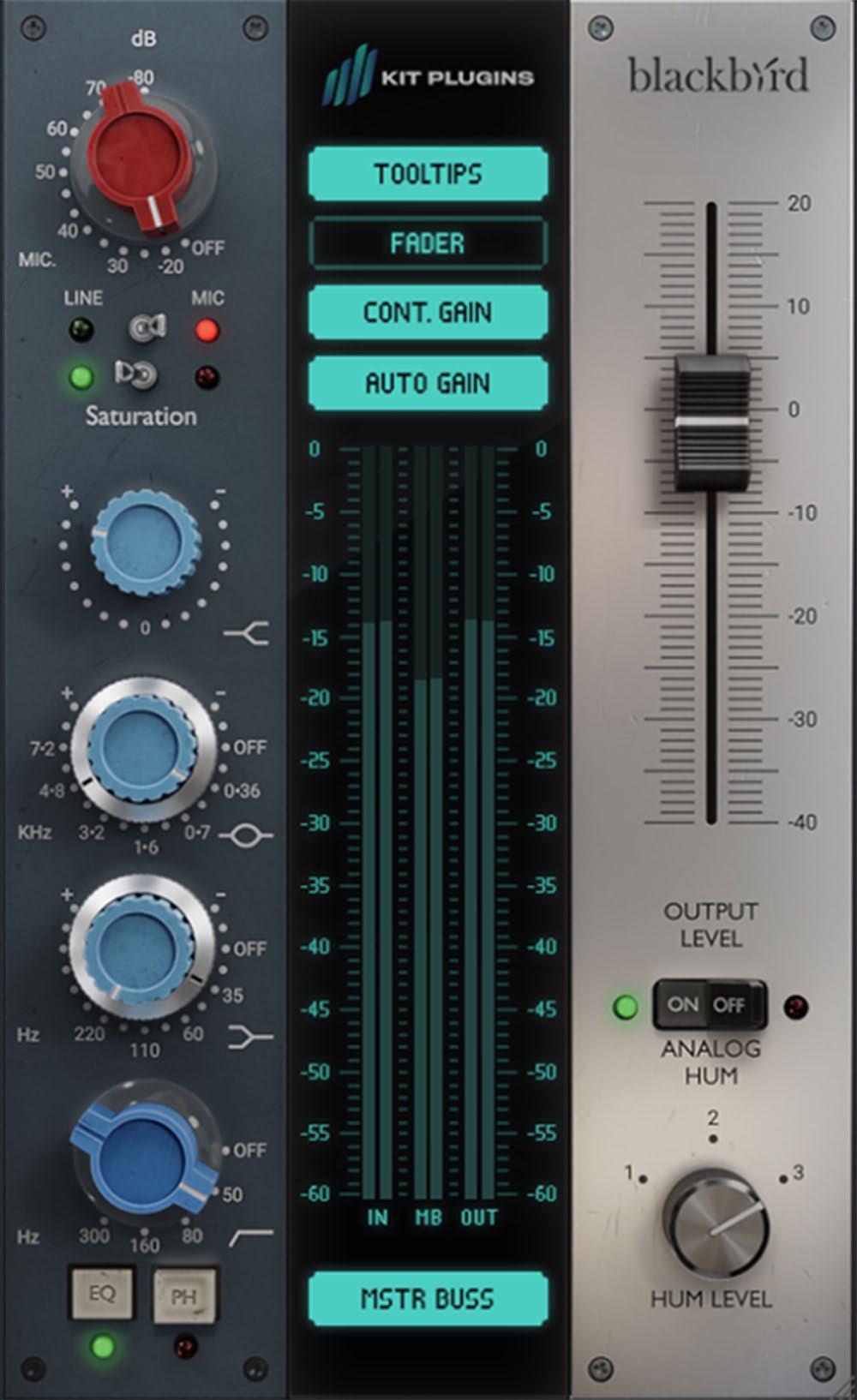
character of the 1073’s line input. Switching the Preamp Mode from Line to Mic is where the BB N73 magic begins, as the user can add as little or much harmonic content to the audio signal as desired. Like the physical 1073, this control is stepped in 5 dB increments.
Users in need of more precise control can grab the Cont. Gain function found in the plug-in’s center section, which activates a continuously variable gain control. While in Mic mode, activating the Preamp Saturation function applies drive, compression and harmonic distortion to the signal. The sound character of the Preamp/Saturation control ranges from subtle to drastic, and even the most discerning listener would be hardpressed to distinguish it from actual analog processing.
In the 1073 tradition, the plugin’s threeband EQ includes a fixed 12 kHz, ±18 dB high-shelf EQ; a selectable (360, 700 Hz, 1.6, 3.2, 4.8, 7.2 kHz) mid-band ±18 dB bell EQ; a selectable (35, 60, 110, 220 Hz) ±18 dB lowshelf EQ; and a selectable (50, 80, 160, 300 Hz) ±18 dB/octave high-pass filter. The EQ button engages/disengages the virtual EQ circuit, while the PH (phase) button inverts the signal 180 degrees.

As expected, the EQ sounds musical and rich, and is suited for virtually any sound source. The high frequency’s fixed 12 kHz is perfectly tuned to add just the right amount of air and sparkle to a vocal, acoustic guitar or acoustic piano without a hint of sounding harsh or brittle. The low-shelf is impeccably fit for adding the perfect low-end boost to kick drum, floor toms or bass guitar.
The N73’s Analog Hum function allows three different levels of modeled noise to be added to the channel. The idea of adding noise sounds a bit sketchy, but once again, KIT nailed it. This “virtual self-noise” perfectly ties a mix together. I utilize this function nearly every time I use the plug-in.
Activating the Link Hum Level option in the Top Bar Controls tab allows the Hum Level between every plug-in instance to be adjusted globally. Once I get the N73 dialed in on all of the tracks where it is inserted, I activate the Link Hum Level and then listen to the three Hum Level options, ensuring that I utilize the one that sounds the best. This linking feature also allows global oversampling to be globally switched between Low, Medium and High. The
differences are minor. High sounds best, but also works the CPU hardest. Users running older machines, or a significant number of plugin instances, may need to land on Medium, or even Low.
Adding to the usability of the plug-in, there’s an Auto Gain function that allows the Preamp Sensitivity to be altered without changing the overall level. As the preamp is turned up, the fader goes down, and when the preamp is turned
COMPANY: KIT Plugins
PRODUCT: BB N73
WEBSITE: www.kitplugins.com
PRICE: $150 on company website
PROS: Realistic saturation; musical; truly sounds good on any source
CONS: None
down, the fader automatically goes up to compensate. This function is invaluable in maximizing the plug-in’s detail, as it allows the precise amount of preamp saturation to be dialed in while listening to the track in the mix without changing the track’s overall gain. After applying the plug-in on multiple session mixes, I’ve found that most tracks, especially kick, snare and vocals, have a magic saturation sweet spot, and Auto Gain allows that setting to be easily determined. Driving the Preamp Sensitivity brings guitar and keyboard tracks to life. I’m hard-pressed to find a situation where any of these sound sources doesn’t sound better when saturation is applied. It also works wonders with keyboards, adding a wonderful musical character and easily transforming a sterile or lifeless patch into something interesting and/or edgy.
Activating the Tooltips function (also found in the plug-in’s center section) offers up another nice addition. When activated, it displays the exact gain addition or subtraction (to the nearest tenth of a dB) on each EQ band and the mic pre. I don’t use it when I’m dialing my mix in, but when I get to the tweaking stage and I’m making slight adjustments, this feature is wonderful.
The center section’s Fader Color function allows the actual color of the fader to be toggled between black, silver, red, blue and teal. When using large instances of the plug-in, this provides better navigation and organization. I match my N73 color with my DAW color (drums-blue, guitars-red, etc.) and I love it.
While somewhat subtle, the Master Buss section is one of the plug-in’s most intriguing features. KIT designed it to emulate the sonic character of the master bus amp in Blackbird’s 8058 desk. Its delicate saturation is wonderfully musical and can be used as an amazing tool to add analog character. In many ways, along with the Hum Level, it adds the sonic glue to a mix.
Designed to provide a comprehensive channel strip in the 1073 tradition, the BB N73 does exactly that. The EQ can be easily used to shape and sculpt a track’s sound, while the preamp and Master Buss section of the plug-in allow the user to add saturation, slight compression and harmonic content to perfectly complement every component of a mix. n
“Bluey” is music mixer Chris Lord-Alge’s affectionate name for his highly modified, silver-faced Universal Audio 1176 Rev A (aka, “blue stripe”) Limiting Amplifier. Rev A serial numbers ranged only from 101-125—UA 1176s were not black-faced until Rev C in 1970, when the “LN” suffix for low noise was added.
There are many discussions and arguments over which version of the 1176 sounds best, although the 1973 1176LN Rev D with serial numbers 1239 through 2331 black-face models are the most highly valued. I am fortunate to own a Rev D, and I did use it for some of the comparisons in this review,
CLA owns four Rev A 1176LN units, but only one of the four is the actual “Bluey,” and sounds different from the other three. It is the one that has been used on 99 percent of the lead vocals in LordAlge’s music mixing work since the 1980s. He has many choices of compressor/limiters but has not been able to equal its particular sound quality and unique processing. This is likely because over the years, it was modified or repaired many times using incorrect, random or unknown parts, making it a one-of-a-kind processor that worked as no other 1176 possibly could.
Working with Lord-Alge, Black Lion Audio examined his 1176 Rev A and reverse-engineered it to produce a two-rackspace 1176 Bluey model (also now available). Based on that unit, the Bluey 500 fits in two slots of a 500 Series rack and is said to be exactly the same except, like all 500 module versions of rack gear, it runs on that system’s standard ±16-volt power supply rails.
Bluey uses CineMag transformers that copy the specifications of the original’s UTC input and Reichenbach output units, and Bluey 500 has many of the modern touches in the 2U model.
For one, there is the added input/output buffering circuitry, providing extra gain for directly inserting Bluey in a console insert point. I found this feature helpful during recording, when the output level (for whatever reason) of mic preamp/ EQ is low. Like any 1176, the Input control knob adjusts how much compression occurs; having extra gain here is useful when tracking.
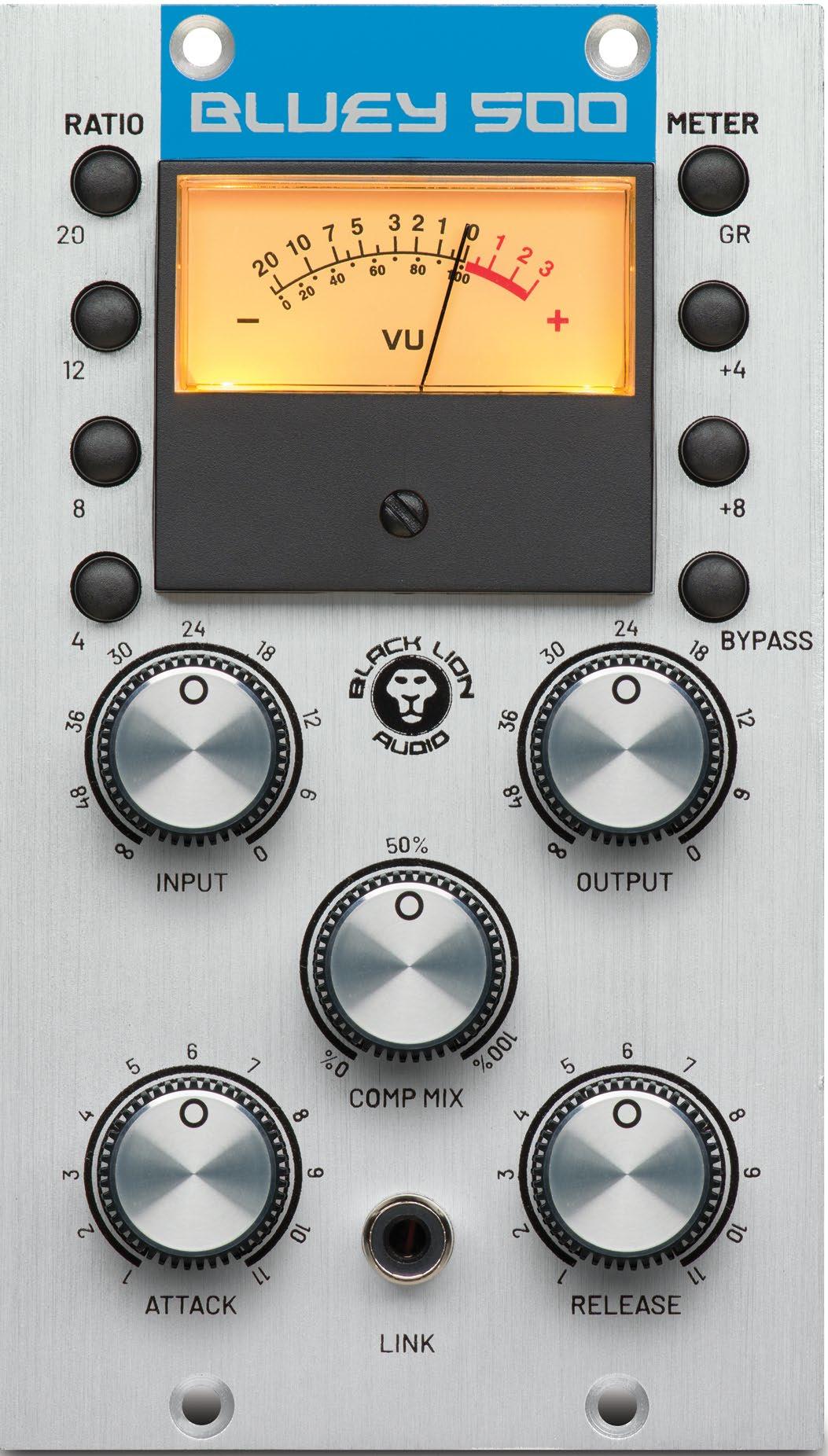
Most significant and “newfangled” is the Wet/Dry control on the front panel. I liked that even with big squashes, I was able to dial back in some dry signal. I found this parallel processing especially useful for vocals and acoustic guitars.
You may stereo-link two Bluey 500s using a front-panel RCA jack and a short cable (not supplied) to another Bluey 500 in any slot in your rack. Not all racks support stereo linking, and some racks only work with single-slot size, side-by-side modules via their rear connectors. An actual stereo-link cable solves all those issues!
I recorded a Gibson J-28 acoustic guitar using a Warm Audio WAMPX single-channel tube microphone preamp connected directly to the Bluey, no EQ. With Bluey’s extra input gain available, there
was always a hot signal and plenty of adjustability; recording the softest finger-picking to hard strumming was no problem.
I used slow attack time and medium release time set to about the middle of the knob’s range. I saw up to -5 dB of gain reduction on the unit’s tiny VU meter using a ratio of 4:1. The sound was clear and present. It operates like any 1176, except for the additional input gain.
My first application as a line-level processor was as an insert in Pro Tools, as I wanted to compare Bluey with my 1176LN Rev D on different sources. I set Bluey to 100 percent wet and duplicated all the source tracks so I could insert my Rev D on one channel and Bluey on another channel. I wanted to try Bluey on all the tracks I would use my 1176 on during a mix.
Because Bluey has more input gain, I would have to use an external linelevel attenuator pad to take the level down about 15 dB, but I found using an adjustable Trim plug-in just ahead of the insert point on the channel was a better idea. The manual has nothing about all this, and I think this additional gain should be a switchable feature. Once I figured it out, I was ready to try Bluey on everything.
The Attack time control on the Bluey works the opposite from my 1176LN. As pointed out in the manual, the fastest attack times (ranging from 20 to 800 uS) are full counter-clockwise, while on the original 1176LN, it is full clockwise. Release times are from 1.2 seconds to 50 mS, and the control works just like the original 1176. Nevertheless, how about marking the fast/slow extremes on the front panel?
For squashing a snare drum track, I used a 20:1 ratio and 100 percent wet. Attack time was at 2 o’clock on Bluey so that the bright attack of the stick hitting the drum was not softened greatly. The 1176LN’s Attack control was straight up by comparison.
Release time depends on the tempo of the song—I was watching the meter(s) wave back and forth with about 15 dB of gain reduction. If the release time is too slow, recovery of gain is incomplete, with the next snare drum hit reduced in level. Also, the live ambience (room leakage) on the snare track will not be completely heard. Release time is important for compression effects!
I had the Input control on Bluey
at maximum and the Trim plug-in set to -12 dB. I set my 1176LN to match Bluey as best as I could with the same Ratio, and similar Attack and Release times, duplicated by listening. The Input control on the vintage 1176LN was nearly maxed, and the Output was at 18 on the front panel.
The differences were audible, and I liked the way Bluey sounded more aggressive and intentional. Even though it was producing nearly the same effect, by contrast, my 1176LN was more “polite” and sedate-sounding, with a slightly warmer sound. Both proved useful in my mixes for different reasons, and it’s great to have the choice.
My 1176LN’s cleaner sound won on bass guitar, although I would not normally use either compressor—my general preference is for a distortionfree and pristine bass sound. Opto- and/or VCA-based compressors are usually my choices here.
I wanted to try Bluey on both male and female lead vocals in various pop/ rock songs I was mixing—I wanted to channel CLA here! First, I inserted Bluey on a female R&B-style singer and achieved good control to keep the vocal up above without having to overpower the track in the mix. Bluey was set to a 4:1 ratio, slowest attack and release, and on vocal peaks, I saw about 15 dB gain reduction. I used some Dry side of the Wet/Dry control to regain some lost high frequencies without adding EQ.
On a particular male lead vocal, Bluey won with the ability to bring forward almost “thrown away” vocal bits and subtleties usually lost when the track’s pumping away. This made for less vocal riding required.
Whether you already have an 1176 or not, the little Bluey 500 fills the bill for vibey control on drums or most midrange elements—vocals, guitars or keyboards! It’s definitely worth checking out. n
COMPANY: Black Lion Audio
PRODUCT: Bluey 500 FET

Compressor/Limiter
WEBSITE: www.blacklionaudio.com
PRICE: $699 MSRP
PROS: Vibey, modified, aggressivesounding and unique.
CONS: Quirks and too much input gain might be a problem for some.
Business doesn’t like uncertainty. The stock market definitely doesn’t like uncertainty. People in general don’t like uncertainty.
But artists have always flirted with uncertainty more than, for example, the HR person at IBM who gets a nice salary plus benefits…right? Well, maybe not. IBM recently announced that it was putting a hold on hiring people if AI could do their jobs better in the near future. That includes HR. So, I guess “human resources” will be changing its name to “talk to the machine resources…”
By Craig AndertonWe’ve seen massive uncertainty in our industry the past couple of decades. People could steal master-quality recordings without the consequences of shoplifting from a record store. CDs got killed off by allyou-can-eat streaming services. Vinyl came back…sort of. Spotify has 210 million paid subscribers—and still lost $248 million in 2023’s first quarter. Big studios folded, while hits were made on laptops in bedrooms. The pandemic destroyed the concert business for a couple years. The annual ritual of trade shows was shattered—in some cases, never to return (I’m looking at you, Frankfurt Musikmesse). Music stores were eclipsed by online e-tailers. Software—which is ever-changing—replaced the certainty of hardware.
Companies thought that people who bought instruments during the pandemic were going to be musicians forever. But they forgot that music is a discipline, and people are lazy. So, companies that once over-hired to meet demand during a bubble had to downsize. And the coup de grâce is the insanely uncertain nature of today’s politics and economics, which hang over our industry as much as they hang over everyone else.
I mean, c’mon…that’s a lot of shocks to the system.
No wonder music has become more like comfort food than a quest for artistic innovation. No wonder brilliant live sound engineers deliver for UberEats, because…well, it’s certain that people will eat. It’s not certain they’ll need brilliant live sound engineers.
What can bring some certainty back into our industry? Spoiler alert: Nothing. And everything.
It’s a cliché that the only constant is change—and because the music industry is a fashion industry (something supposedly brilliant venture capitalists can’t seem to grasp…but I digress), change is embedded in what we do. We’re better equipped to make dramatic pivots than those working in IBM’s HR department. Some of the longest-lasting musical careers—the Beatles, David Bowie, Madonna, Cher—built those careers on constant re-invention. We’re fortunate to be in an industry where change is considered desirable.
So, we can’t hold back change. Nor should we. Instead, let’s exploit it.
Consider trade shows. The old model is fading, and NAMM knows this. Instead of giving up, they’re looking at how to re-shape the trade show concept to remain relevant in today’s uncertain world. The TEC Awards is transforming itself from an old-school awards show into more of an experience. Smaller shows, like Superbooth and Synthplex, target their audiences with laser-like precision to fill the void left by larger shows. Sure, changes won’t be perfected overnight—but even the process of change can maintain relevance.
In the author part of my musician/author life, printed books about music technology have become obsolete because technology changes so fast. Now, I write only eBooks with free “point” updates, just like software. With this model, those who might previously have been reluctant to buy a technology book because they think the product will change next week— they might not be so reluctant.
Musically speaking, now is the time for artists to embrace re-invention. When the world wants to play it safe, you can give it comfort-food music— or you can give a reason not to play it safe. If what you do takes off, that’s great. If it doesn’t…well, what you were doing probably wasn’t going to, either.
Other possibilities: Music education is always a target for cutting, and let’s face it, manufacturers rarely see education as their job. What if music stores transitioned away from sales and toward in-person lessons and consulting on how to use gear better, and make better music?
I’ve done workshops at events where people are more than happy to pay for the privilege of learning, so maybe the market is there. The stores can stop paying huge amounts of rent because they wouldn’t need the space to warehouse a zillion instruments (and tie up bucks in inventory). Meanwhile, the people who did great mixing for local shows can stop delivering for UberEats and teach people how to mix.
Manufacturers need to realize that we have enough emulations of LA2A compressors. But do we have reverbs that cancel out the dry component from algorithmic reverb, so that a dry/wet control is truly dry/wet, and not dry/wet+residual dry? It sounds cool, but no plug-in does that—you have to cobble it together with two reverbs, phase switches and buses. Multiband processing is pretty much unexplored, aside from dynamics. Processors could derive control signals from a musician’s playing beyond envelopes, like a “pluck detector” for guitar whose control signal depends on how fast you’re playing.
Uncertainty creates fear. Fear is a destructive force in people’s lives, and in society. But when it comes to our industry (cliché alert!), we have nothing to fear but fear itself. In good times, our industry thrives on change. It can do so in uncertain times, too—but that’s up to us. ■


